Top 120 Greatest Inventions That Have Changed the World Forever
Technological inventions have transformed the world, changing our ancestors' lives and allowing us to prosper and build the future we enjoy today.
From making stone tools to inventing the first wheel, machines, Mars rovers, and artificial intelligence... humanity is paving the way for a new era.
The truth is that groundbreaking human inventions and technologies have shaped civilizations and improved life on Earth.
Many of these inventions were truly revolutionary, laying the groundwork for a new era even when it was not immediately apparent.
The most important inventions are often the result of a multigenerational process that is interconnected.
The following is a list of over 120 inventions that are regarded as the most popular and significant in history, having helped to change the world.
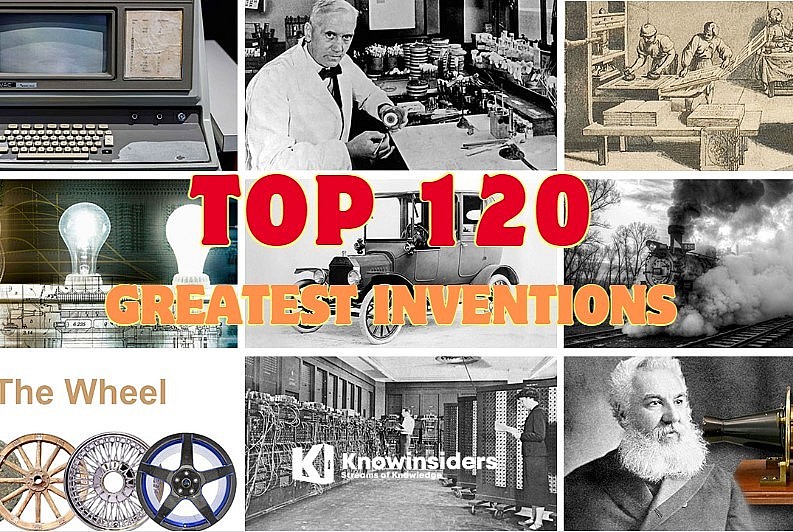 |
| Top 10 Important Inventions That Changed Our World - Most Amazing Inventions Of All Time |
Top 120 Greatest Inventions That Have Changed the World
1. First Tools
Similar to the use of fire, tool use probably originated before Homo sapiens sapiens and may even date back 2.6 million years or more. A number of animal species are known to use tools nowadays.
According to anthropologists, the ability to use tools was a crucial step in human evolution. Sticks, stones, and fire might have been among the first tools. But, depending on its application, practically anything can be a tool.
2. First Fire - 64,000 years ago
 |
| Humans discovered fire tens of thousands of years ago |
Despite being a natural occurrence, the discovery of fire as a practical tool revolutionized human history. It's possible that the deliberate use of fire existed before Homo sapiens sapiens.
Cooked food has been found dating back approximately 1.9 million years, predating the evolution of Homo sapiens. Additionally, there is proof that our ancestors, Homo erectus, used fire under control as early as 1,000,000 years ago.
Fire-burned flint blades have been dated to approximately 300,000 years in the past. Additionally, there is proof that approximately 164,000 years ago, early modern humans routinely heated stone to enhance its flaking ability for use in toolmaking.
A hotly contested theory holds that hominids' ability to cook over fire allowed for a greater variety of foods to be consumed, which in turn allowed our species' larger brain to develop in the first place.
Fire has been used for many purposes throughout history, including rituals, agriculture, cooking, signaling, industrial processes, agriculture, and destruction. It is without a doubt one of the greatest inventions that ever took place.
First Zippo - 1932Zippo elevated the already-cool smoking habit from the early 1900s. When the original Zippo was introduced in 1932, nobody anticipated that it would become a smoking community status symbol. In January 1933, the lighter was put into mass production, and in that first month, the factory was able to produce 82 units. Not bad for a business founded by George Blaisdell and operated by his two employees. It was quite an accomplishment given that they only used basic tools like a kitchen hotplate, a used welding kit, and a punch press. Next month, there was an increase in production capacity, producing 367 units. More than 500 million Zippos had been produced at its bigger, more advanced facility in Bradford, Pennsylvania, by 2012. |
3. First Wheel - 3500 B.C
 |
| Wheel - a great invention of mankind |
One of the most well-known inventions and a marvel of original engineering is the wheel. Not only did this fundamental technology facilitate travel, but it also laid the groundwork for a plethora of other creative technologies.
Interestingly enough, though, the wheel is not that old. Mesopotamia produced the earliest wheel ever discovered, some 3500 B.C. By that time, people had created metal alloys, constructed sailboats and canals, and created intricate instruments like harps.
The main reason for the delay is that the idea behind this project was not to create a wheel—that was probably invented the first time someone saw a rock rolling—but rather to create a wheel that could be attached to a stable platform using a fixed axle. A wheel with no fixed axle is not very useful.
4. First Concrete - 3000 BC
Cement, an essential component of concrete, is estimated to have been created circa 1300 BC. Subsequently, cement would be mixed with other substances to create a mixture that was closer to the concrete that we know today. For instance, the Romans are renowned for their concrete, which is still used in many of the buildings they built. However, it might be older still.
The exterior of the clay fortresses built by the Middle Eastern builders was covered with a thin layer of moistened burned limestone, which formed a hard, protective surface through chemical reaction with airborne gases.
In the areas of southern Syria and northern Jordan, Bedouins or Nabataean traders constructed the earliest concrete-like structures circa or before the third millennium BC. The importance of hydraulic lime was recognized by 700 BC, which prompted the creation of mortar supply kilns for the building of concrete floors, subterranean waterproof cisterns, and houses with rubble walls.
The Egyptians used early concrete forms as mortar in their buildings circa 3000 BC. Englishman Joseph Aspdin created Portland cement in 1824. In 1893, George Bartholomew established the nation's first concrete-paved street, which is still in place today.
Concrete reinforced with steel had been developed by the end of the 1800s. Steel-reinforced concrete was used in the design and construction of an apartment building in Paris by August Perret in 1902. This structure inspired the creation of reinforced concrete and was widely admired and popularized for its concrete construction. In 1921, Eugène Freyssinet built two enormous parabolic-arched airship hangars at Orly Airport in Paris, thereby paving the way for reinforced concrete construction.
5. First Nail - 3400 BC
Among the most significant and possibly underappreciated inventions is the nail. Prior to the development of nails, wood structures were frequently constructed with rope between adjacent boards. Certain societies have created intricate woodworking methods to join wooden constructions.
Although the exact date of the invention of metal nails is unknown, bronze nails from approximately 3400 BC have been discovered in Egypt. Over time, iron and steel—the majority of which were produced by hand—replaced them.
Up until the 1790s and the early 1800s, nails were typically made by hand. Since nails are so widely available and easily mass-produced these days, most people take them for granted.
6. First Locks- 2000 BC
Few people are aware that the lock and key system, which is widely used today, was created by the ancient Egyptians approximately 2000 BC.
Back then, the only locations with locked doors were places of worship like mausoleums, temples, or locations with a lot of wealth.
7. First Currency - 118 BC
Coins, precious metals, shells, and even livestock have all been used as forms of currency throughout history. As a guarantee against future payments for precious metals, banks issued paper notes in response to frequent coin shortages and portability problems.
It's possible that the Han Dynasty in China, which ended in 118 BC, is when the idea of using paper or another light material as money first emerged.
Governments were relieved when paper money replaced precious metal-based money during times of crisis. As a result, it brought about a significant shift in the global economy by introducing a new monetary system.
 How Much Money Is There In The World? How Much Money Is There In The World? |
8. First Paper- 105 AD
Paper's history is inextricably linked to the advancement of human communication and civilization. Before the invention of paper, information was recorded and transmitted using a variety of materials. Although they have all been used, materials like leaves, seashells, and animal pelts cannot ensure ease of use or effective information preservation.
Papermaking was invented in China during the second century BC. The first sheets of paper were made by them from leftover bamboo and tree fiber. Later, the process of creating paper was enhanced by the use of mulberry tree tree fibers. This advancement fostered the growth of culture and communication in addition to aiding in the efficient storing of information.
China was the first country to invent paper manufacturing, which later extended to nearby areas and eventually other continents. Paper first made its appearance in India, Iran, and Europe during the eighth century thanks to trade and cultural exchanges. This dispersion not only improved convenience but also encouraged the advancement of science and culture in new areas.
9. First Abacus- 190 AD
About 190 AD, the use of the abacus with its beads in a rack was first recorded in China. For centuries, the Chinese version of math computation proved to be the fastest method and, with proper use, can still surpass the speed of electronic calculators.
10. First Gun - 1000 AD/13 century
Humanity has utilized weapons since the beginning of time. Nonetheless, there is no denying that gunpowder and firearms have revolutionized humankind. Around the ninth century, China is credited with the invention of gunpowder, though it may have first been used for fireworks.
One of the earliest firearms was a bamboo tube that was used in China circa 1000 AD to fire a spear using gunpowder.
Gunpowder led to the creation of the cannon in the 13th century. The biggest step that led to the modern gun was Smith and Wesson’s metal-cased cartridge, first fired in 1857.
 Top 10+ Rarest Guns Still Exist in the World Today Top 10+ Rarest Guns Still Exist in the World Today |
11. First Compass - 1190
Some people think that the original purpose of this comparatively new invention was "geomancy" and fortune telling. It wasn't until much later that it was modified for navigation. Around 200 BC, the Chinese are most likely the people who created the first compasses that resemble modern ones.
The mineral magnetite occurs naturally in lodestone, which was used to make early compass models. There is evidence that suggests lodestones may have been used for comparable purposes as early as the sixth century BCE by civilizations. People started hanging the lodestones so they could move freely and use them for navigation at some point, maybe around 1050 AD.
By the time a European book written in 1190 AD describes the use of a magnetized needle by sailors, it's likely that using a needle as a compass was common practice.
12. First Button- 1235
While the ancient Greeks used simple loops and buttons to fasten tunics, it was the buttonhole that popularized the small plastic discs with holes that are now used to decorate modern clothing.
13. First Printing Press- 1436
The first printers in history were the Chinese, who began practicing block printing as early as 500 AD. However, Johannes Gutenberg, a German goldsmith, was the first to build a press.
Even though he was by no means the first to automate the process of printing books, German goldsmith Johannes Gutenberg is frequently credited with creating the printing press circa 1436 AD. China has been printing woodblocks since the 9th century, and bookmakers in Korea were using movable metal type a century before Gutenberg.
On the other hand, Johannes Gutenberg's device enhanced and popularized presses in the West. By the year 1500 AD, Gutenberg presses could be found all over Western Europe, producing enormous amounts of written content, ranging from single pages to books and pamphlets.
14. First Condom - 1640 (3,000 years ago)
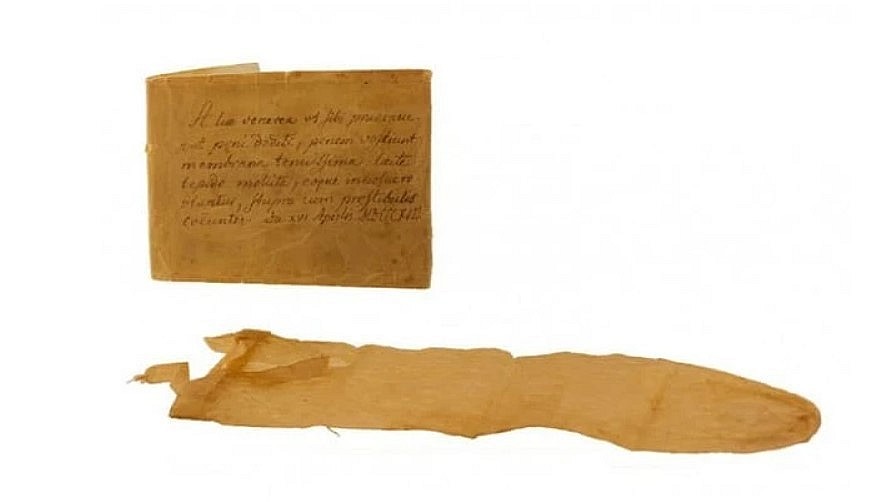 |
| One of the first condoms was made of linen paper |
Egyptians donned them 3,000 years ago and the 16th-century Italian gynaecologist Gabriele Falloppio first advocated their use to prevent the spread of disease.
Condoms have long been an effective tool for preventing pregnancy and sexually transmitted infections.
Much evidence suggests that condoms were used by ancient Egyptians around 1,000 BC. To protect themselves from infectious diseases, they used thin animal skins.
Furthermore, there is significant evidence of condom use among Europeans. They were discovered in 1,800-year-old paintings on cave walls in the Combarelles region of France.
In 1500, an Italian scientist named Gabriele Fallopio was the first to document the linen condoms he made. These raincoats are also soaked in chemicals. He claimed that this helped 1,000 customers test condoms to effectively prevent syphilis.
The oldest condoms were discovered at Dudley Castle in Birmingham, UK. They were small models of fish and animal intestines created in 1640.
In 1839, Charles Goodyear developed a vulcanization method that made rubber flexible. People have considered making condoms from new materials. However, because the new products are as thick as bicycle inner tubes and smell bad, they are not very popular.
The second revolution began in 1930, with the invention of latex. This substance quickly takes over due to its toughness and lack of odor. This is the raw material used in most condoms today.
15. First Steam Engine - 1698
It is believed that Jerónimo de Ayanz, a mining administrator from Spain, was the first person to create a steam engine. He held a patent for a device that pumped water out of mines using steam power.
The first workable steam engine was created in 1698 AD, according to engineer and inventor Thomas Savery of England. His invention used steam pressure to extract water from flooded mines. Savery developed his engine based on ideas proposed by British physicist Denis Papin, a French-born man who created the pressure cooker.
Thomas Newcomen, another Englishman, created an enhanced engine in 1711. Later, in 1781 AD, James Watt, a Scottish instrument maker who worked for Glasgow University, significantly improved Newcomen's engine's functionality by adding a separate condenser. This allowed the steam cylinder to be kept at a constant temperature. Later, he created a double-rotating steam engine that was used to power factories, trains, mills, and a variety of other manufacturing processes by the 1800s.
16. First Film - 17th Century
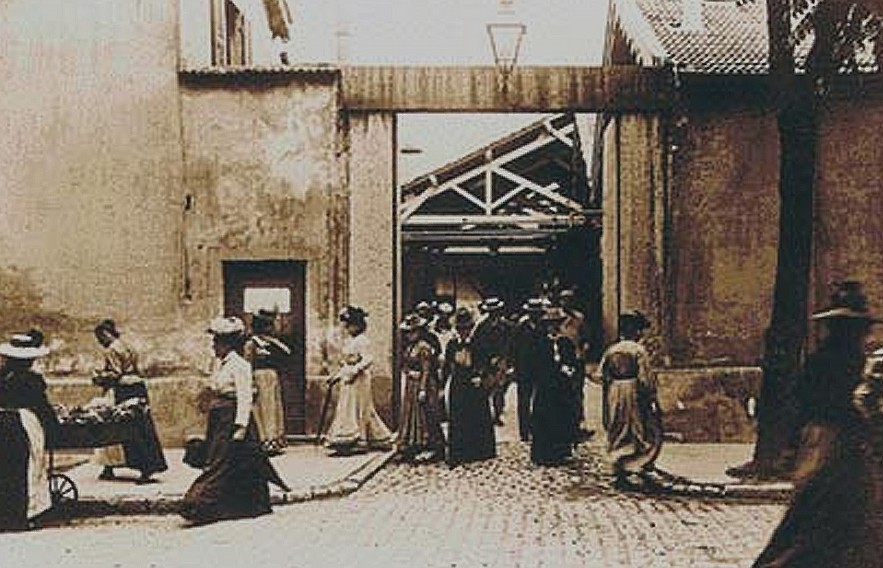 |
| La Sortie de leucine Lumière a Lyon |
Plays and dance, which shared characteristics with film in the form of scripts, sets, costumes, production, direction, actors, audiences, and storyboards, served as early sources of inspiration for motion pictures. Later in the 17th century, animation produced by different mechanical slides was projected onto lanterns.
The first motion picture film to be captured on camera using a Cinématographe was La Sortie de leucine Lumière a Lyon (Workers leaving the Lumière factory at Lyon) in March 1895.
The beginning of projected cinematographic motion pictures is commonly believed to have occurred on December 28, 1895, when ten of the Lumière brothers' short films were screened for commercial and public audiences in Paris.
17. First Automobile - 1769
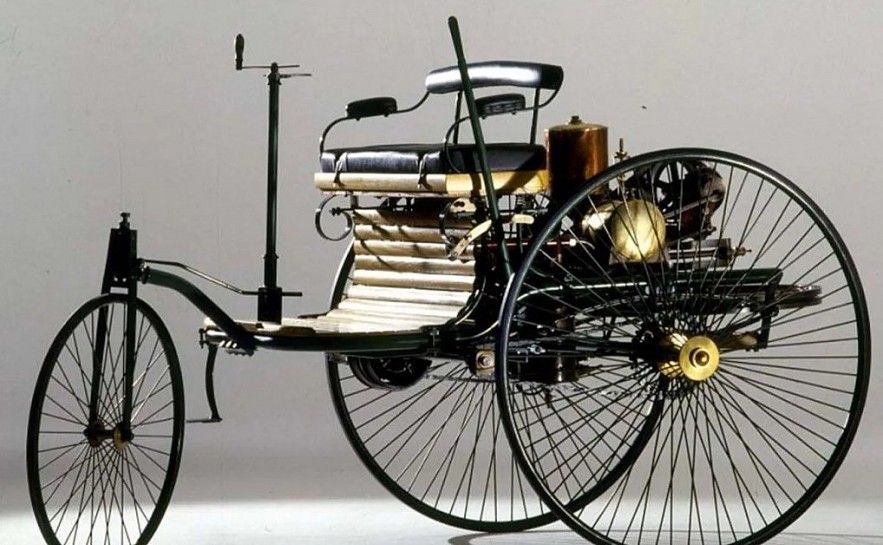 |
| 1886 Benz Patent Motorwagen |
Some people believe that Karl Benz, a German inventor who patented his Benz Patent-Motorwagen in 1886, is responsible for the invention of the modern car. But since Nicolas-Joseph Cugno created the first steam-powered vehicle that could carry people in 1769, autos have been in development.
Many people have made contributions to the development of the automobile and its component parts over the years. Henry Ford came up with strategies at the start of the 20th century to make cars affordable for the majority of people. After that, these methods were adopted as standard operating procedures by General Motors and Chrysler.
Read more: What was The First Car ever made in the World?
18. First Electricity - 1799
Electricity is another indispensable invention that has become a basic necessity for day-to-day living. While electricity has existed for a long time, its useful applications have only recently been developed.
Most people agree that Alessandro Volta is the person who discovered the first usable "battery." In 1799, he created his voltaic pile. It was made up of cardboard that had been dipped in brine and placed between discs made of two distinct metals, like copper and zinc.
British scientist Michael Faraday discovered the fundamentals of producing electricity in 1831. The discovery of electromagnetic induction transformed the way energy is used. The foundation of contemporary industrial society is now the increased usability of electricity.
19. First Battery- 1800
Italian physicist Luigi Galvani observed that touching a dead frog's leg with two pieces of metal caused it to twitch in the 1780s. The first battery was created by his friend, professor Alessandro Volta, using voltaic cells arranged in a Voltaic pile.
The Parthian empire, which existed approximately 2,000 years ago, may have produced the first device based on the concepts of what would eventually become the battery. The ancient battery was made of an iron rod encircled by a copper cylinder that was placed inside a clay jar that had been filled with a vinegar solution.
It's possible that silver was electroplated using this apparatus. However, as was indicated in the previous entry, Alessandro Volta, the creator of the pile battery, was the first person to create an electric battery.
Following that, William Cruickshank created the trough battery in 1800 AD as an advancement over Alessandro Volta's voltaic pile.
The French physician Gaston Planté created the first rechargeable battery in 1859 AD using lead acid, which marked a significant advancement in the field of batteries. Waldemar Jungner made the first Nickel-Cadmium (NiCd) battery available in 1899.
20. First Advent of Steel - 1800
After people discovered how to make steel, a much harder metal created by heating iron with carbon, iron's use spread. A people known as the Chalybes lived near the Black Sea and used iron ore to make strong wrought iron weapons with about 0.8 percent carbon around 1,800 BC.
Around 500 BC, cast iron—which contains 2–4% carbon—was first produced in ancient China. The iron ore was melted down into a liquid by the Chinese metalworkers in massive furnaces, which they then poured into carved molds. Indian metalworkers developed a smelting technique in approximately 400 BC that involved holding the molten metal in a clay container known as a crucible. The laborers filled the crucibles with charcoal fragments and wrought iron bars, sealed the lids, and placed the containers inside a furnace.
The carbon in the charcoal was melted and absorbed by this wrought iron. The crucibles held pure steel ingots, which are considerably stronger and less brittle than iron, when they cooled. Steel became even stronger as a result of the blast furnace's later development. In 1856 AD, British engineer Henry Bessemer created a method of producing pure iron without carbon by blasting air through molten pig iron.
One of the largest industries in the world, steel production was made possible by the well-known Bessemer Process invention. These days, steel is used to build skyscrapers and bridges alike.
21. First Locomotives - 1804
In addition to being able to transport heavy loads over great distances, locomotives can comfortably accommodate large numbers of passengers. Though wagons have been transported across tracks, or rails, since the sixteenth century, the history of train travel as we know it today is barely 200 years old.
In 1804, British engineer Richard Trevithick constructed the first operational full-scale steam railway locomotive in the United Kingdom. The engine was powered by steam under high pressure. The world's first steam-powered railway journey took place on February 21, 18044, when Trevithick's unnamed steam locomotive pulled a train along the Welsh tramway.
But Trevithick's locomotives were too hefty for the still-in-service cast-iron plateway track. Train networks first became commercially available in the 1820s. George Stephenson was hired in 1821 as an engineer to work on the northeastern Stockton and Darlington Railway, which became the first steam-powered public railway in 1825. With the construction of his renowned steam engine, Rocket, in 1829, the railway era got underway.
22. First Mechanical Computer - Early 19th century
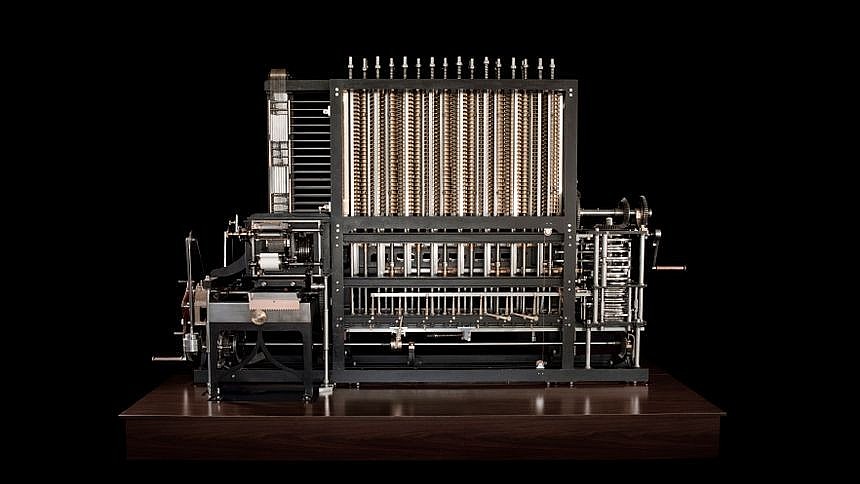 |
| First Mechanical Computer |
The term "computer" was first used in Richard Braithwaite's book The Yong Man's Gleanings in 1613, where it was used to refer to a human performer of computations. Before mechanical machines with the primary function of calculation emerged at the end of the 19th century as a result of the industrial revolution, the definition of a computer remained unchanged.
Charles Babbage (1791–1871), known as the "father of the computer," developed and created the first mechanical computer at the beginning of the 1800s. The path leading to the modern computer started with those first hesitant steps.
Many sets of numbers could be calculated by the Difference Engine, and hard copies of the results could be produced. Ada Lovelace, whose work is regarded as the first computer programming, provided Babbage with some assistance in the development of the Difference Engine. Sadly, Babbage was never able to finish building a fully functional version of this machine due to financial constraints. For Babbage's bicentennial, the London Science Museum finished the Difference Engine No. 2 in June 1991. The printing mechanism was finished in 2000.
While there isn't a single person who invented the modern computer, Alan Turing's 1936 paper "On Computable Numbers, with an Application to the Entscheidungsproblem" laid out the fundamental ideas of contemporary computer science. Computers are now the archetypal image of the contemporary world.
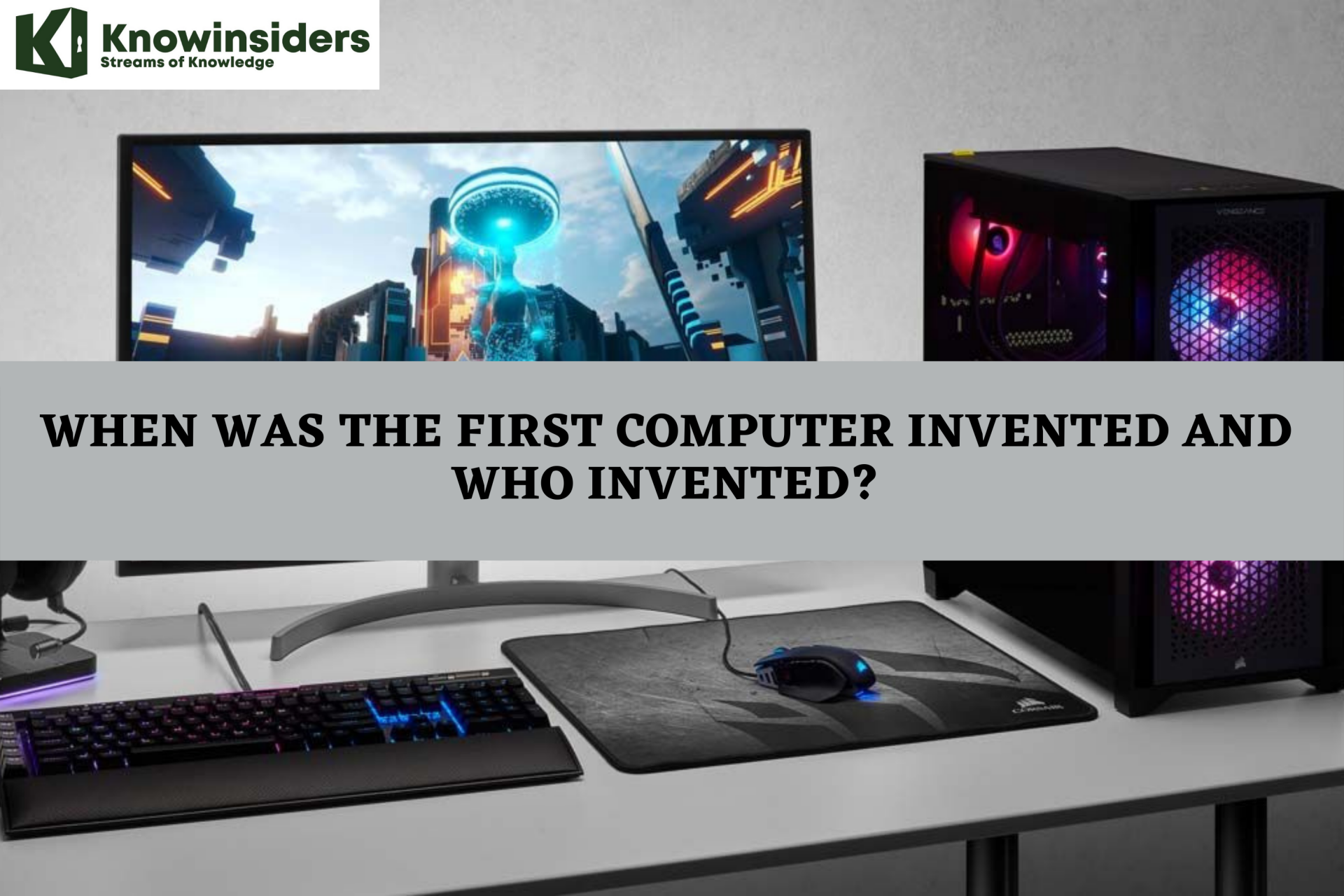 When Was The First Computer Invented and Who Invented? When Was The First Computer Invented and Who Invented? |
23. First Bicycle by Baron von Drais - 1817
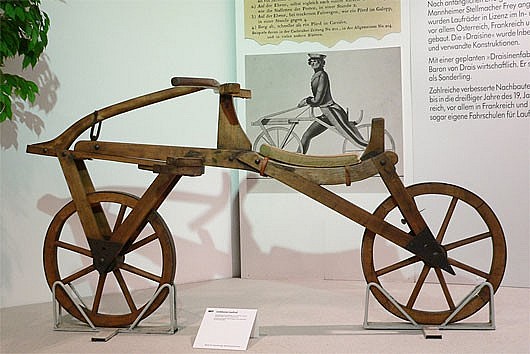 |
| Bicycle by Baron von Drais |
One could argue that the bicycle originated in Germany in 1817. The idea to create a vehicle that could propel its owner faster and run on human strength came from Baron von Drais. He presented Laufmaschine, a "walking" machine (meaning "foot-powered machine" in German), in 1817. By the time of his "introduction" on June 12, 1817, he had covered 13 km in approximately one hour.
Because Laufmaschine is almost entirely composed of wood, it is also known as Draisine (English), Draisienne (French), or Hobby Horse (wooden horse). The vehicle, which has two equal-sized wooden wheels covered in iron and fixed in a straight line on a wooden frame, weighs 22 kg. There is a brake on the back wheel and steering on the front wheel. When the driver pushes his foot back onto the ground, the vehicle moves forward.
For this invention, he received a commercial patent in 1818. Despite the fact that thousands of them were produced, mostly for the Western European and North American markets, there remained a disadvantage: maintaining balance while adjusting control was extremely challenging. Due to the growing number of accidents, users swiftly rejected Drais's invention, leading some local governments to outlaw the use of these kinds of vehicles.
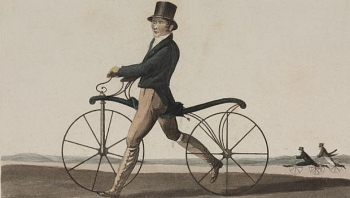 What is the First Bicycle in the World History What is the First Bicycle in the World History |
24. First Camera - 1826/Digital Camera - 1975
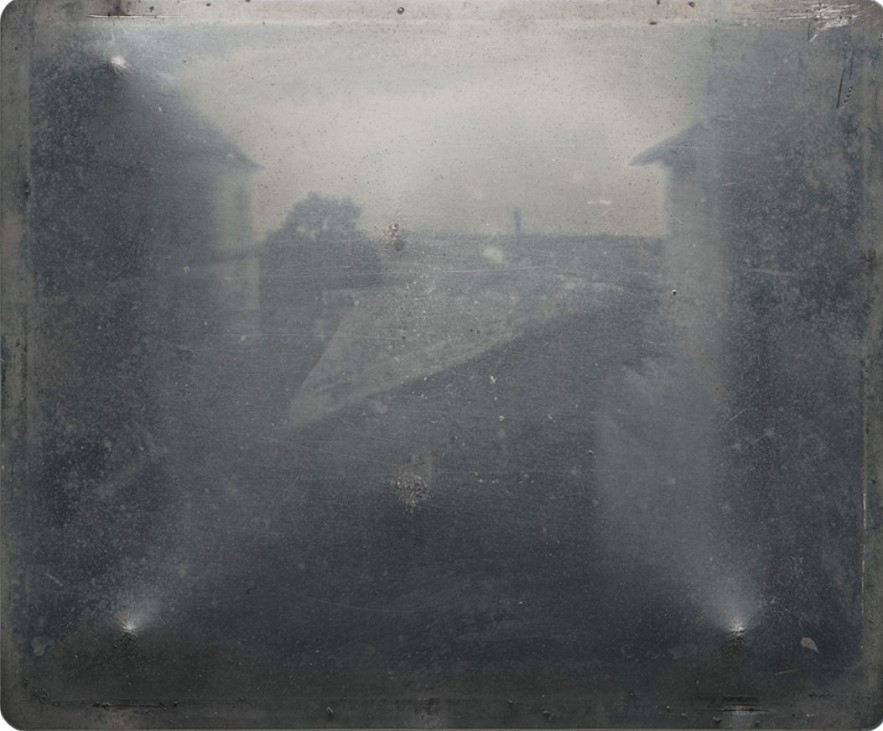 |
| Using a camera obscura, Joseph Nicéphore Niépce (1765–1833) took the oldest known photograph in 1826. The image, called View from the Window at La Gras, was taken at the time and was called a heliograph. The way Nièpce's lens captured the image permanently on light-sensitive silver chloride-coated paper was innovative. |
Despite the fact that British polymath William Talbot invented one of the first cameras, Joseph Nicéphore Niépce took the first known photograph on a pewter plate in 1826.
Using a sliding wooden box camera made by Charles and Vincent Chevalier, Joseph Nicéphore Niépce captured the first known permanent photograph in 1826 AD.
Technological developments led to the development of digital cameras, which store images on memory cards rather than film. The digital camera's history is said to have begun with Eugene F. Lally's idea to take pictures of the planets and stars.
Afterwards, Steven Sasson, an engineer at Kodak, designed and produced the first digital camera in 1975 AD. It was put together using kit pieces that were lying around the Kodak facility. The breadbox-sized camera took twenty-three seconds to take a single picture.
Read more: Who Invented the First Camera in the World
25. First Friction Match by John Walker - 1826
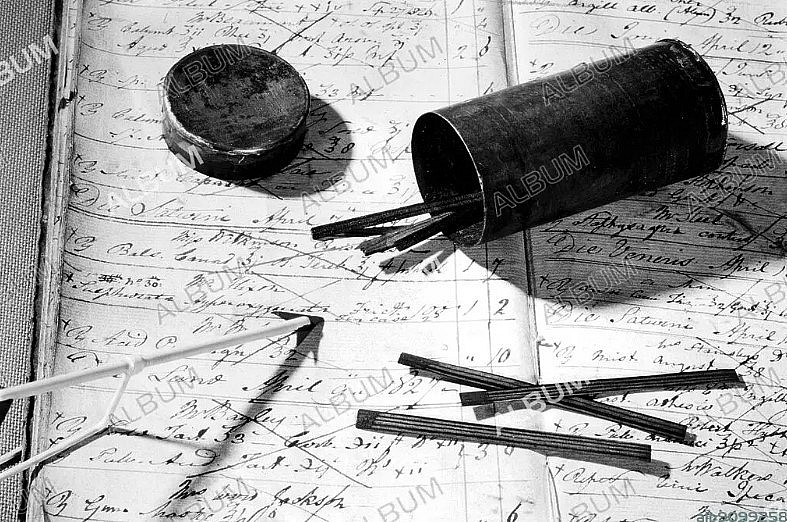 |
| Walker's Friction Match |
In Stockton, John Walker is widely recognized for creating the friction match in 1826. But it took decades for him to receive the proper credit for his discovery from other researchers; only then did he receive it.
John Walker lived during a period when new discoveries regarding the production of light were being made. Light and heat were produced using fossil fuels like coal and gas. Walker started experimenting with chemicals and explosives as a result of his work as an independent chemist. He also started looking for a simple and safe way to start a fire.
He accidentally made his first friction match in 1826 when he scraped a wooden stick he was using to stir chemicals against his home hearth and it ignited. On April 7, 1827, he sold his first box of friction matches at his shop after perfecting the chemical formula.
Even after renowned scientist Michael Faraday advised him to, Walker did not patent his matches. Other innovators were thus able to use his creation as a model for their own friction matches. Walker, however, continued to have success selling his matches, which allowed him to retire and live comfortably on his earnings. He passed away in Stockton on May 1st, 1859, and was not given credit for his invention at the time.
26. Morse Code by Samuel Morse - 1830
Samuel Morse and other inventors created the telegraph in the 1830s and 1840s, which completely changed long-distance communication.
A wire installed between stations transmits electrical signals, which are used by the system to function. Furthermore, Alfred Vail and Samuel Morse created a code that was eventually dubbed Morse code for the straightforward transfer of messages over telegraph lines. The English alphabet and numbers were given a set of dots (short marks) and dashes (long marks) by the code, depending on how often they were used.
Some academics claim that the telegraph played a key role in establishing the groundwork for contemporary amenities like computers and phones.
27. First Barcode- 1952
Barcodes were conceived as a kind of visual Morse code by a Philadelphia student in 1952. Now, black stripes have appeared on almost everything we buy.
28. First Fridge by Jacob Perkins - 1834/35
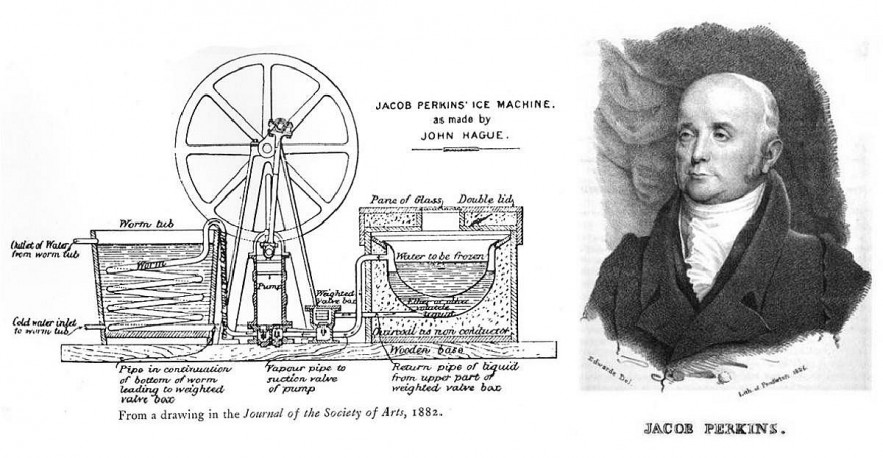 |
| First Fridge by Jacob Perkins |
The first person to explain how food could be kept cool using pipes packed with volatile chemicals that evaporated quickly was Jacob Perkins.
Jacob Perkins was an American inventor, mechanical engineer, and physicist who lived from 1766 to 1849. Among his numerous patents was one for a refrigerator. He is regarded as the father of the refrigerator as a result.
Oliver Evans, another American inventor, had come up with the concept for the refrigerator. Though he never built it, he had the idea in 1805. The vapor-compression refrigeration cycle was first patented by Perkins on August 14, 1835, under the title "Apparatus and means for producing ice, and in cooling fluids."
29. First Light Bulb by Joseph Wilson Swan - 1850
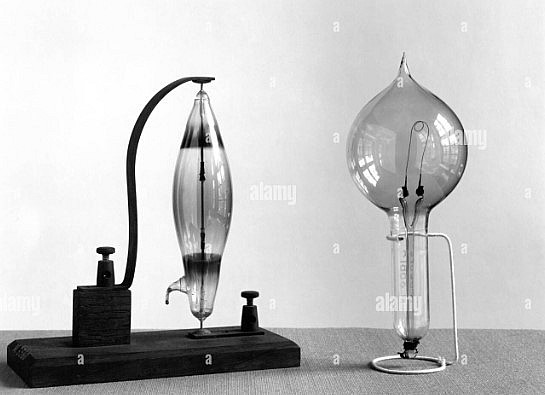 |
| Light Bulb by Joseph Wilson Swan |
Although Joseph Swan invented the lightbulb before Thomas Edison did, the two eventually collaborated and are now jointly credited with producing the device that we may take for granted more than any other.
A brilliant idea from more than 150 years ago is the source of the light we use in our homes and offices today. Humphry Davy, who conducted electrical experiments and created the electric battery, is credited with creating electric lights in the early 19th century. He created light by connecting wires between a piece of carbon and his battery, causing the carbon to glow.
The electric arc lamp was the name given to his creation. Other inventors produced "lightbulbs" over the course of the following 70 years, but these were not viable for commercial use.
By encasing carbonized paper filaments in an evacuated glass bulb, English physicist Joseph Wilson Swan invented the "light bulb" in 1850. However, his bulb had too short a lifespan for commercial use without a strong vacuum. But in the 1870s, Swan created a longer-lasting lightbulb and better vacuum pumps became accessible.
By employing metal filaments, Thomas A. Edison enhanced Swan's design. He filed patent applications for electric lights with various filament materials in 1878 and 1879. Electric Light Company started promoting their new offering.
Inventor Timeline• English chemist Humphry Davy created the first electric light in 1809. Davy inserted a charcoal strip between the other ends of two wires that he had connected to a battery. As a result of the charged carbon glowing, the first electric arc lamp was created. • In 1820, Warren de la Rue used an evacuated tube to enclose a platinum coil and run an electric current through it. Although his lamp design was functional, it could not be widely adopted due to the high price of platinum, a precious metal. • James Bowman Lindsay used a prototype lightbulb to demonstrate a continuous electric lighting system in 1835. • Using a charcoal filament, Edward Shepard created the first electrical incandescent arc lamp in 1850. In the same year, Joseph Wilson Swan began working with carbonized paper filaments. • In 1854, German watchmaker Heinrich Göbel created the first real lightbulb. He employed a glass bulb with a carbonized bamboo filament inside of it. • The mercury vacuum pump, created in 1875 by Herman Sprengel, allowed for the development of the first workable electric lightbulb. As de la Rue had found, the light would reduce internal blackening and lengthen the filament's lifespan by generating a vacuum inside the bulb and removing gases. • Henry Woodward and Matthew Evans filed for a light bulb patent in 1875. • In 1878, English physicist Sir Joseph Wilson Swan (1828–1914) became the first person to create a workable and longer-lasting electric lightbulb (13.5 hours). Swan made use of cotton-derived carbon fiber filament. • Thomas Alva Edison created a forty-hour-burning carbon filament in 1879. Edison put his filament in a lightbulb without oxygen. (Edison modified his lightbulb designs based on the patent he acquired from Matthew Evans and Henry Woodward in 1875.) By 1880, his bulbs had a 600-hour lifespan and were dependable enough to be commercially viable. • Irving Langmuir created argon and nitrogen-filled bulbs in 1912, along with a tightly wound filament and an internal hydrogel coating, all of which increased the bulb's longevity and efficiency. |
30. First Internal Combustion Engine - 1859
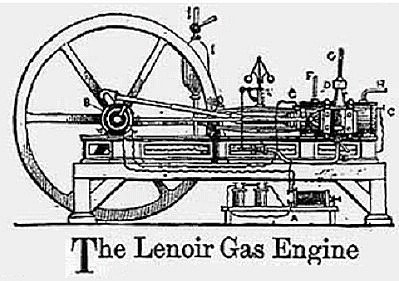 |
| First Internal Combustion Engine |
Étienne Lenoir, a Belgian inventor, is credited with creating the first functional internal combustion engine when he converted a steam engine in 1859. The billions of engines that have been constructed since were inspired by it.
Engineer Jean Joseph Étienne Lenoir, also referred to as Jean J. Lenoir, was a Belgian-French who created the internal combustion engine in 1858. He lived from 12 January 1822 to 4 August 1900. As early as 1807 (the De Rivaz engine), such engines were commercially unsuccessful despite earlier patents for similar designs. Lenoir's engine was the first internal combustion engine to be successfully commercialized in large enough quantities.
Mussy-la-Ville, which was a part of Luxembourg, a Belgian province, was the place of his birth until 1839. He moved to France in 1838 and settled in Paris, where he became interested in electroplating. His fascination with the topic inspired him to create a number of electrical innovations, such as an enhanced electric telegraph.
31. The First Crude Oil Well- 1859
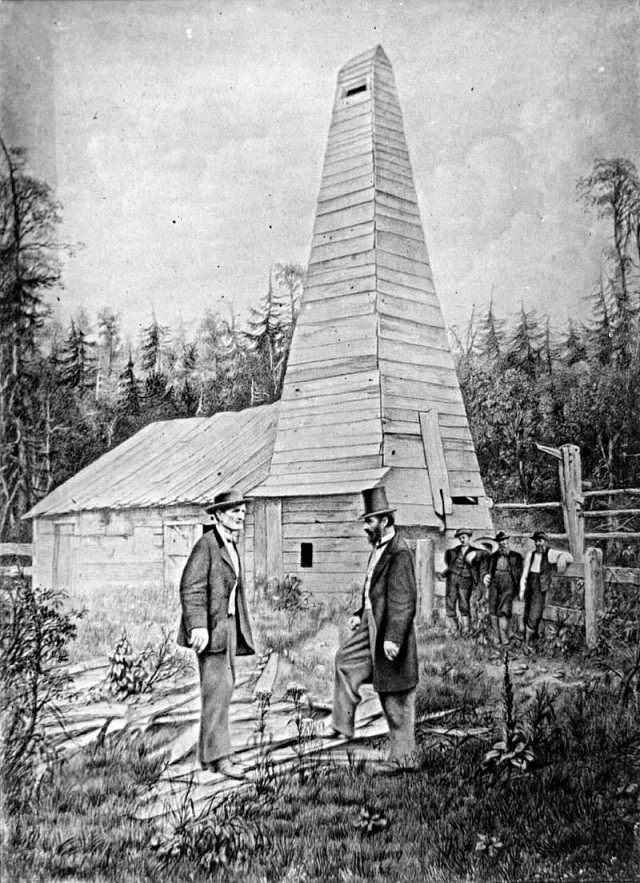 |
| Drake (right) in front of the well |
Prior to the discovery and widespread use of gasoline, camphene—a mixture of alcohol, typically methanol and turpentine—was the preferred fuel. Later, kerosene would mostly take its place.
In Pennsylvania in 1859, the nation's first oil well was dug, and the oil was refined to produce kerosene. Gasoline was also a byproduct of the distillation process, but it was discarded. Only about 20% of gasoline could be produced from a given amount of crude petroleum using the distillation refining method.
The Drake Well is an oil well located in Cherrytree Township, Venango County, Pennsylvania, that is 21.2 meters (69.5 feet) deep. Its success led to the country's first oil boom. Situated 3 miles (5 km) south of Titusville, the Drake Well Museum is centered around the well.
Located on the banks of Oil Creek, the first commercial oil well in the United States was drilled by Edwin Drake in 1859. In 1966, Drake Well was named a National Historic Landmark and placed on the National Register of Historic Places. In 1979, it received the designation of Historic Mechanical Engineering Landmark. In 2009, the well was honored with a National Historic Chemical Landmark designation on the occasion of the strike's semicentennial.
But the refining procedure was improved when it was found that light fuels like gasoline were ideal for internal combustion engines. With the use of pressure and chemical catalysts, a new method for producing gasoline more readily was introduced in 1913. Refining gasoline became more feasible and efficient thanks to the introduction of a new thermal cracking process that doubled output.
32. First Barbed Wire by Joseph Glidden - 1874
 |
| Barbed Wire |
The first rolls of barbed wire on the market were created using manual production methods. Until 1874, Joseph Glidden, an American citizen, succeeded in building a machine to produce barbed wire despite numerous failures.
Since then, the steel wire manufacturing industry has grown significantly, allowing users to use high-quality barbed wire products at much lower prices. This machine's invention, as well as subsequent research, improvements, and technological upgrades, have resulted in high-quality, low-cost, long-lasting products that save labor and time.
33. First Telephone by Elisha Gray and Alexander Graham Bell - 1876
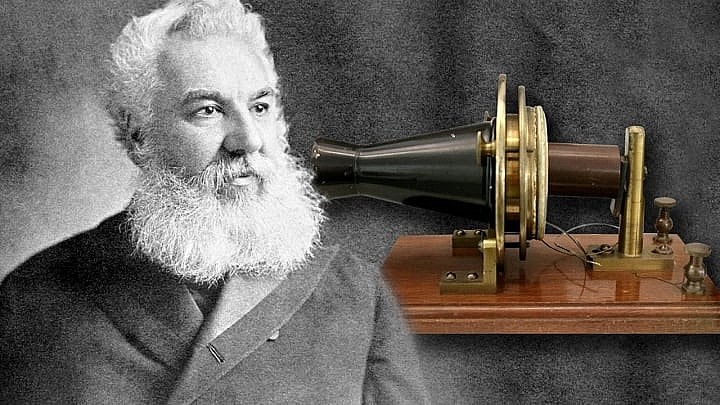 |
| Alexander Graham Bell was the first person to patent the telephone. |
Philippe Reiss, a German teacher, invented a device in 1860 that used electricity to transmit sounds. Despite his best efforts, he was unable to sell his invention. The machine's lack of utility and the difficulty of directly conveying speech are the causes.
Both Eliza Gray and Alexander Graham Bell in the US had finished sound transmitter models by 1975. Both presented their telephone patents on February 14, 1876. But it wasn't until June 1876 that someone saw a functional telephone at the Philadelphia fair.
Alexander Graham Bell established the Bell Telephone Company in 1877 and popularized telephone use in the US. In 1877, Union Telegraph requested that Thomas A. Edison create a new telephone in order to compete with the Bell Company. Edison started working on creating the first graphite microphone, a variable resistance transmitter that was more sensitive than Bell's.
A few weeks later, Bell continued to introduce Hand Telephone, which meant that the phone race between the two sides had no end in sight. Bell's machine was enhanced by Frédérick Gowe at the close of 1877, and his system was put into use in Paris in 1879. This is regarded as France's original telephone center.
As previously stated, Eliza Gray and Alexander Graham Bell both invented the telephone, but history only acknowledges Alexander Graham Bell as the primary inventor with patent number 74465, issued March 7, 1876, following a legal dispute.
Nonetheless, a number of data and information sources suggest that the phone prototype was created beforehand. They didn't agree that Alexander Graham Bell invented the telephone. They think Antonio Meucci is the person who invented the telephone.
He spoke with Alexander Graham Bell about this invention in 1860 and placed the first phone call to his spouse. It was not acknowledged at the time, though, because he lacked the funds to register the copyright. Alexander Graham Bell was the one who came up with the invention and registered the telephone's copyright.
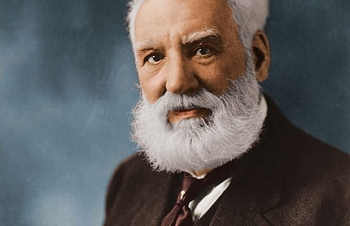 The First Telephone in the World: Who is Inventor and Facts The First Telephone in the World: Who is Inventor and Facts |
34. First Antibiotics by Alexander Fleming - 1877/1928
 |
| Alexander Fleming |
Millions of lives have been saved by antibiotics, which both eradicate and stop the spread of dangerous bacteria. In 1877, Louis Pasteur and Robert Koch published the first descriptions of the use of antibiotics.
Penicillin was discovered in 1928 by Alexander Fleming and was derived from a type of mold.
Antibiotics were a major living improvement that spread quickly during the 20th century, fighting almost every known infection and preserving human health. However, overuse and prescription of them may soon make them ineffective.
35. First Hair Dryer by Alexander Godefroy - 1890
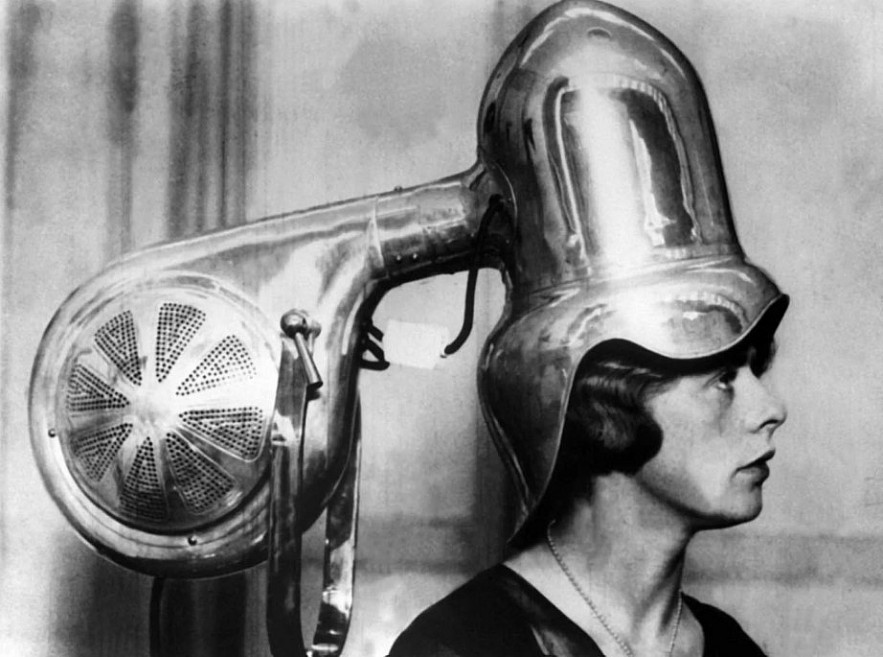 |
| First Hair Dryer |
French hairstylist Alexander Godefroy created the first hair dryer in 1890. This is a massive sitting device that dries hair and creates heat when its end is fixed in one location and fastened to the gas stove chimney.
It was referred to as a blow dryer back then since it could be used to apply heat to objects other than hair. The blow dryer and hair dryer have many features in common and differences as well, but it is clear that the latter is made especially for styling hair.
The first models were large and difficult to use. One of the businesses that helped create the portable hair dryer in the 1920s was Hamilton Beach. When the engineers of the company attempted to create a machine that would force heated air into milkshakes, they discovered it.
Read more: What is the First Hairdryer In the World?
36. First Electric Kettle by Leslie Large - 1891
The kettle-shaped vessel is not a novel idea. It has actually been around for thousands of years.
Mesopotamia yielded one of the oldest kettle discoveries. The concept of heating water with electricity was conceived by American inventor Leslie Large. It was decorative and made of bronze, of course. After a few more years, the Carpenter Electric Company produces its first electric kettle.
In 1891, the Carpenter Electric Company in Chicago produced the first kettle to heat water using electricity. Nevertheless, a significant design flaw caused the water to take longer than ten minutes to boil. Unlike modern kettles, the heating element in this kettle was located outside of the water, in a separate compartment.
The Swan Company discovered the solution in the 1920s by enclosing the element in a metallic cylinder and submerging it entirely in the water. Heating happened much more quickly, and soon after, other producers adopted the same design. Until World War II, when shortages forced a switch to ceramics, the kettles were typically made of metal.
Arthur Leslie Large is recognized as the inventor of the electric kettle, even though he may not have been the first. His modification of the plug-in model effectively made the whistling kettle obsolete because it was now easier to use the electric version due to the world's increasing electrification.
37. First “Clasp-locker (Zipper) by Judson - 1893/1913
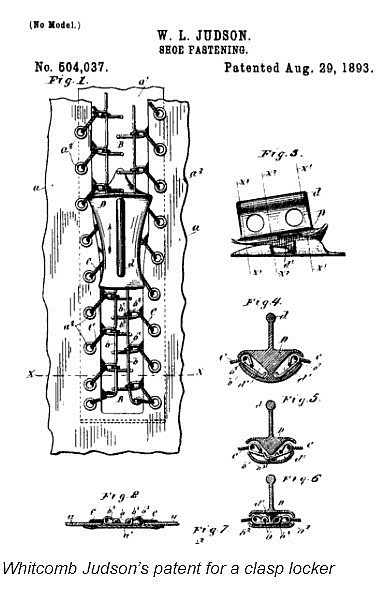 |
| First Zipper by Judson |
Whitcomb L. Johnson created the first zipper, known as the "clasp-locker," in 1893. However, the contemporary version of the zipper that we are all familiar with and use today was created in 1913. Only about 24,000 of them were sold in the first four years, and it took a while for it to catch up with the rest of the world.
The modern zipper became instantly popular after it was lauded by Esquire magazine in the 1950s as a tailoring idea for men. YKK, a Japanese company, is one of the largest zipper producers in the world today, turning out over seven billion pieces annually.
38. First Radio - 1895
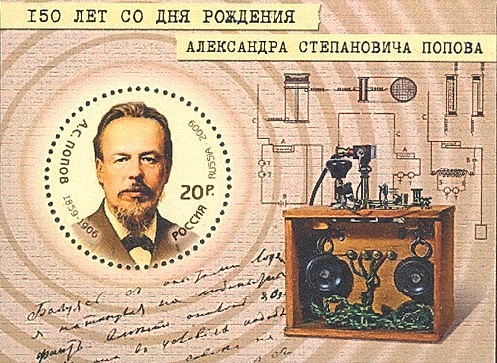 |
| First Radio by Popov |
Nobody can still definitively say who invented the radio. Nonetheless, a lot of people credit renowned Russian physicist Alexander Stepanovich Popov with creating radio.
Popov became interested in high-frequency electrical phenomena while he was employed as a teacher at a Russian naval academy. He gave a paper on a wireless lightning detector he had constructed to identify radio noise from lightning strikes on May 7, 1895. The device used a combiner. In the Russian Federation, this day is also recognized as Radio Day.
But when discussing the invention of radio, we also need to include other scientists like Guglielmo Marconi, Nikola Tesla, George Gerts, and Ernest Rutherford. The truth is that numerous scientists from various nations made this astounding discovery almost simultaneously.
Read more: China Sky Eye - Biggest Radio Telescope in the World
39. First Transistor Radio - 1947
Bell Laboratory's 1947 invention of the transistor led to the rapid availability and superiority of transistor radios over earlier vacuum-tube models. Despite its lackluster performance, more than 100,000 Regency TR-1 units were sold when it first appeared on store shelves in 1954. In just ten years, from the 1960s to the 1970s, billions of transistor radios were produced. As a result, it became the most widely used electronic communication device ever used by humans.
40. First X-rays - 1897
Among the truly revolutionary developments in medicine is the invention of the X-ray machine.
And physicist Wilhelm Conrad Röntgen made the accidental discovery of them. He was examining a nearby chemically coated screen to see if cathode rays could pass through it when he noticed a glow from it.
He gave the rays the name "x-rays" because of their unclear nature. He discovered by observation that x-rays that penetrate human flesh can be captured on camera.
During the Balkan War in 1897 AD, x-rays were used to locate bullets and broken bones inside of patients. For his efforts, he was awarded the 1901 Nobel Prize in Physics.
41. First Electric Razor - 1898
The electric razor that we are all familiar with was developed by a number of people. John F. O'Rouke was one of them, and in 1898 he submitted the first patent application for an electrically powered razor. Gradually, others did the same, such as Philips professor Alexandre Horowitz, who in 1930 also submitted a patent application for a corresponding grooming instrument. The Remington Rand Corporation produced the first electric shavers in 1937.
Prof. Alexandre Horowitz of Philips invented the rotary shaving head, which made it possible for the razor to sever at skin level. In the 1960s, newer models with integrated rechargeable batteries started to be released. These days, a lot of them are also waterproof.
42. First Aspirin by Reverend Edward Stone - 1757/1826
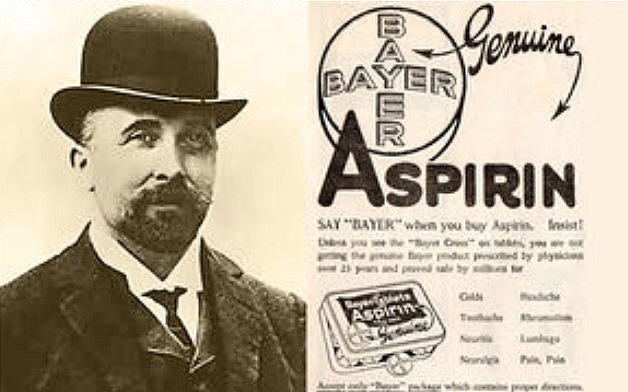 |
| Aspirin |
Aspirin is one of the most widely used painkillers in the world because it is inexpensive, simple to make, and easy to use. This is also the reason for the long-standing confusion surrounding the drug's inventor's story. Contrary to popular belief, Hippocrates was not the father of medicine and is not considered the father of aspirin.
Hippocrates possessed no particular technique for producing a medication akin to aspirin in modern times. So, who did actually create aspirin? The lengthy tale began with an English missionary named Reverend Edward Stone in the eighteenth century.
When Stone tried chewing white willow leaves around 1757, he found that they were very bitter. The idea to use this plant for medicinal purposes came from Stone. To lower his fever, he collected a kilogram of willow leaves, dried them, ground them into a powder, boiled them in hot water, and then steamed them every four hours. This unintentionally contributes to the concentration and increase of salicin in willow leaves, which has an immediate effect on Stone's body.
Stone conducted personal trials on himself before writing up and submitting a report to the British Royal Academy of Sciences regarding willow leaves' ability to reduce pain. One could argue that he was the first to discover how salicin could be used to create the modern aspirin. Brugnatelli and Fontana, two Italian scholars, succeeded in extracting salicin from willow leaves in 1826, but it took them almost a century.
The field of salicin research has advanced rapidly since Brugnatelli and Fontana's discoveries. German pharmacist Johann Andreas Buchner gave salicin an official name in 1828 and increased the yield of salicin extract from willow leaves. The Latin word "salix" (meaning willow) is where the name "salicin" originates.
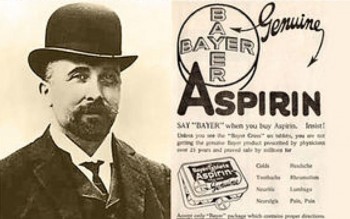 Who Really Was the Father of Aspirin Who Really Was the Father of Aspirin |
43. First Microphone - 19th century
Although the microphone was created in the 19th century for use in telephones, no one seemed to realize that it could also be used to enhance the loudness and clarity of vocal performances. Mice moved from phones to recording studios and nightclubs at the start of the 1920s.
It goes without saying that by then, the electrical circuitry and design had improved significantly. Microphones not only enhanced the volume of a singer's voice but also enhanced the sound of musical instruments; as a result, people were able to enjoy better music. The advancement of microphones happened quickly between 1926 and 1930.
44. First Autonomous Vacuum Cleaner - 1901
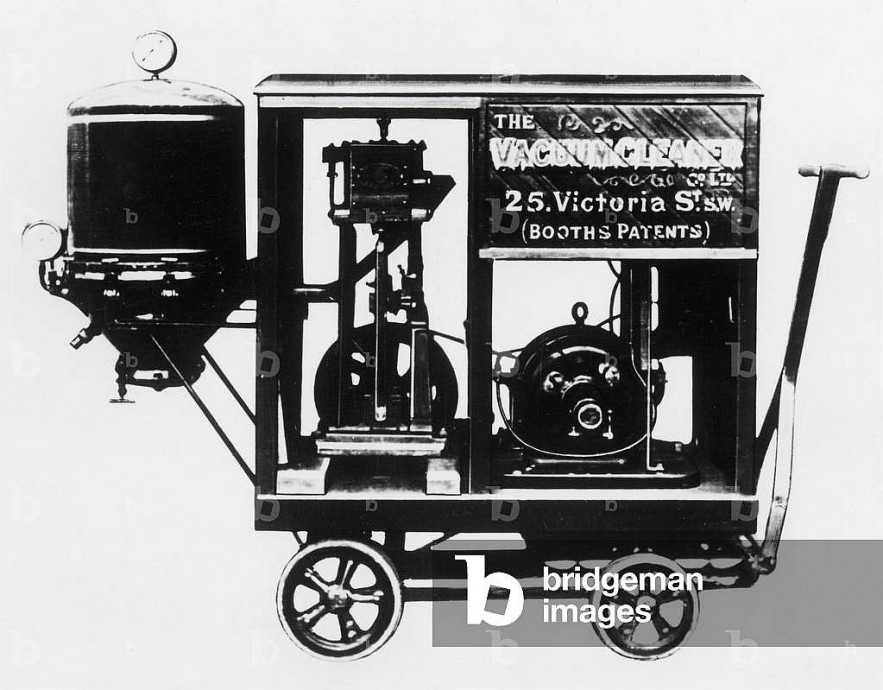 |
| The original vacuum cleaner, 1901 |
Hubert Cecil Booth and David T. Kenney created the first powered vacuum cleaner with a suction mechanism in 1901, but it was a stationary model. Walter Griffiths built a portable home-grade vacuum cleaner four years later.
But until the Second World War, the middle class continued to view the appliance as a luxury. With time, advancements in technology undoubtedly reduced the cost of the appliance. The autonomous robotic vacuum cleaner model, which was created by Electrolux Trilobite in 1997 and debuted in 2001, is one of the most recent innovations in the global vacuum cleaning industry.
45. First Smoke Detector - 1902
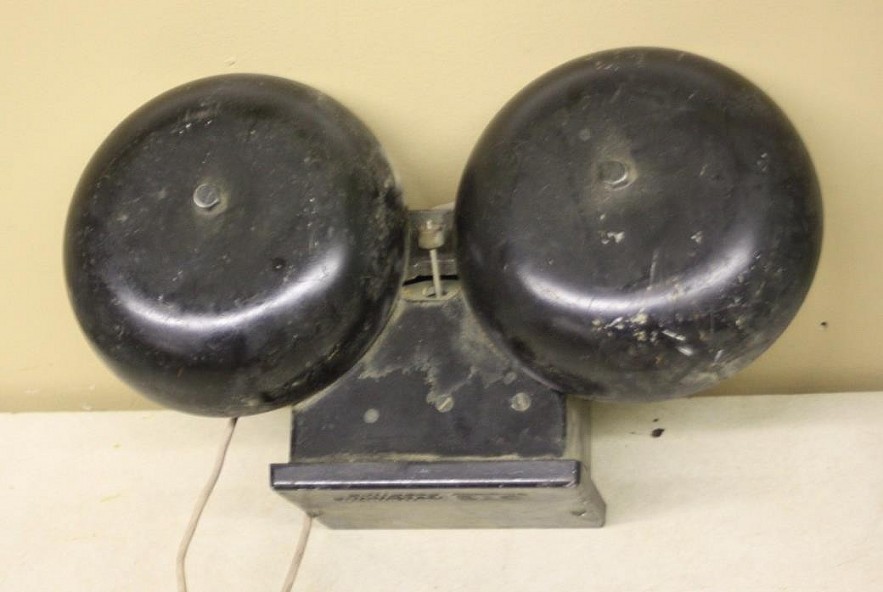 |
| First Smoke Alarm |
Francis Robbins Upton received the patent for the fire alarm in 1890, but George Andrew Darby received the patent for the electrical heat detector in 1902. Large, expensive smoke detectors were first offered for sale in the US in 1951, but because of their high cost, they were only practical for use in commercial and industrial settings. Statitrol Corporation's founder, Duane Pearsall, created the first small battery-operated smoke detectors for homes in 1965.
After one of his coworkers smoked straight into a generator fan in a room used to measure ion concentration, he unintentionally discovered the invention. One of the technicians noticed that the ion concentration indicator flat-lined when the exhaled smoke entered the inlet. Even though Pearsall did not intend to save lives when he founded the company, he succeeded in doing so.
46. First Airplane - 1903
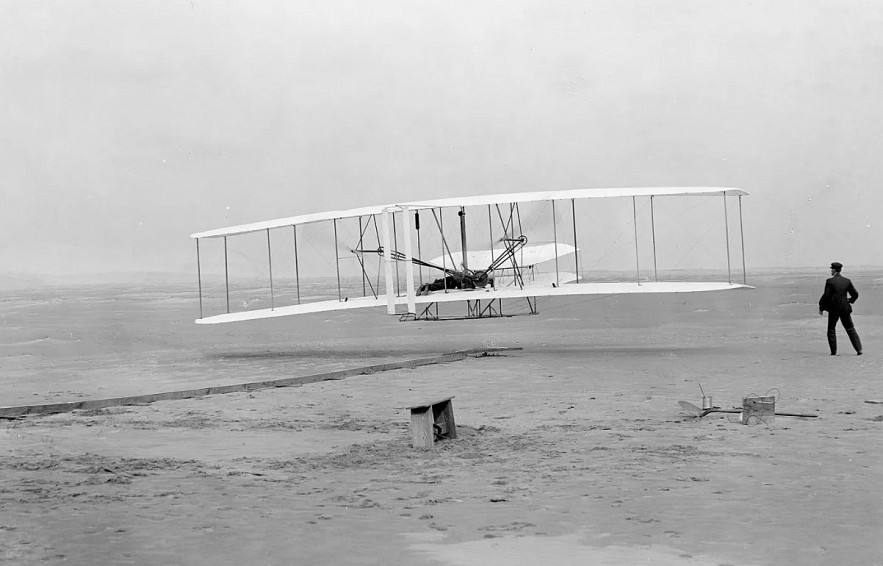 |
| Orville Wright beginning the first successful controlled flight in history, at Kill Devil Hills, North Carolina, December 17, 1903 |
Wilbur and Orville Wright accomplished the first powered, sustained, and controlled flight on December 17, 1903. This was a day that history would never forget.
Since at least the time of Leonardo da Vinci, people have imagined flying machines. However, the Wright Brothers were the first to accomplish controlled powered flight because of the labors of innumerable inventors spanning several centuries.
The pair's accomplishments, starting with their work on gliders, set the standard for contemporary aeronautical engineering by illuminating what was feasible.
Read more: What is the First Plane in The World?
47. First Bra by Mary Phelps Jacob - 1913
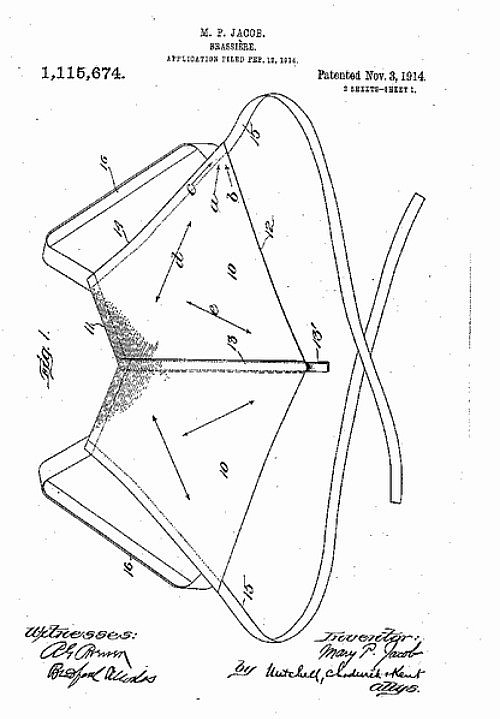 |
| The original patent of the backless brassiere, by Mary Phelps Jacob |
The modern bra is credited to New York socialite Mary Phelps Jacob, who created it as a replacement for the hideous corset.
Mary Phelps Jacob received the first brassiere patent in history in 1914. She created her revolutionary invention in 1913, and the US Patents Office received the finished product after extensive testing. She quickly sold Warner Brothers Corset Co. the patent, and over the next thirty years, the company made over $15,000,000 from it.
48. First Contraceptives - 1914
The first written accounts of contraceptives date to approximately 1500 B.C., when Egyptian women were known to make a thick, solid paste known as pessary by combining honey, sodium carbonate, and crocodile dung, which they would then insert into their vaginas prior to having sex. But a lot of researchers think that traditional birth control is dangerous and ineffective.
About 3000 B.C., the first known condom (made from a goat bladder) was used in Egypt. Rubber condoms were mass produced after Charles Goodyear's patent on vulcanization of rubber was granted in 1844 AD.
The term "birth control" was first used in 1914 by New York state nurse and sex educator Margaret Sanger, who published a monthly newsletter called "The Woman Rebel." Later, Carl Djerassi succeeded in developing a progesterone tablet that prevented the ovulation process.
When "The Pill" was approved for sale in 1960, it set off an international revolution that freed First women from unplanned pregnancies that could ruin their lives and gave them the freedom to choose when to have children.
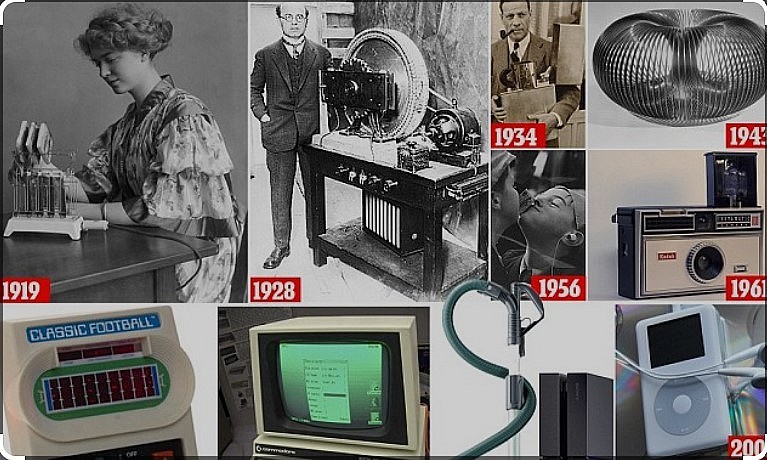 |
| Top 10 Important Inventions That Changed Our World - Most Amazing Inventions in History |
49. First Stopwatch - 1916
Although they were developed within the last century, stopwatches had an accuracy of only about 1/5th to 1/10th of a second in their early models. That ought to be accurate enough in the real world, but watchmakers are known to demand more.
The Mikrograph, an accurate 1/100th of a second stopwatch invented by TAG Heuer, rocked the industry in 1916. TAG Heuer was chosen to serve as the official timekeeper for three Olympic Games because of its accuracy (1920, 1924, and 1928). Developed by Cox Electronic Systems, digital stopwatches with an accuracy of 1/1000th of a second were first introduced in 1971.
50. First Modern Lie Detectors - 1918
Torture was used in the early versions of lie detectors. Some people think that the practice of using boiled water to detect lies by investigators dates back to the Middle Ages. Everyone agreed that someone who was honest would be able to take the heat better. Although there have been lie detectors since the late 1800s, William Moulton Marston invented the device that (possibly) correctly showed a significant relationship between systolic blood pressure and lying. In 1918, he released his writing. Declaring himself to be the "father of the Polygraph," Marston
51. First Car Radio - 1920s
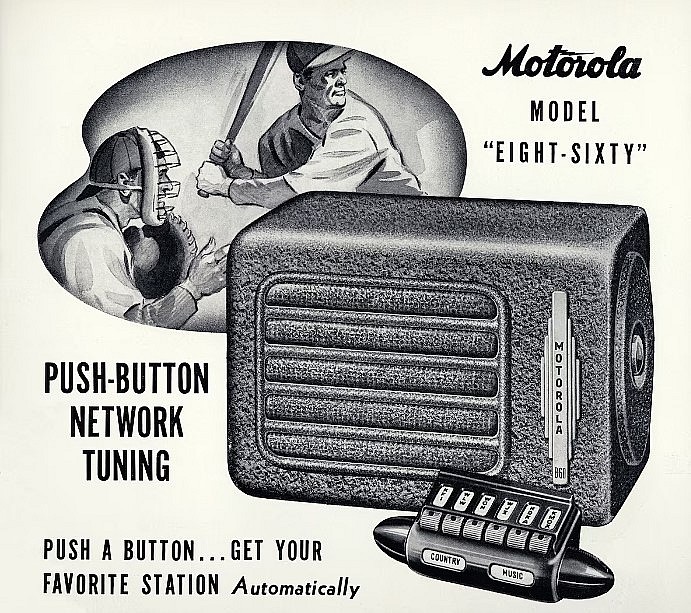 |
| A flyer for a push-button Motorola car radio, a common option on cars starting in the late 1930s. |
Chevrolet was the first company to install a radio in a car, but it was a messy and costly process; in the 1920s, the cost of an aftermarket add-on alone was $200, or about $2,700 in modern currency.
When personalized radio installation became accessible in 1926, Paul Galvin installed a radio in his Studebaker and began receiving orders. His business, which he called Motorola, went on to become one of the most well-known in the technology sector.
52. First Blender by Stephen Poplawski - 1922
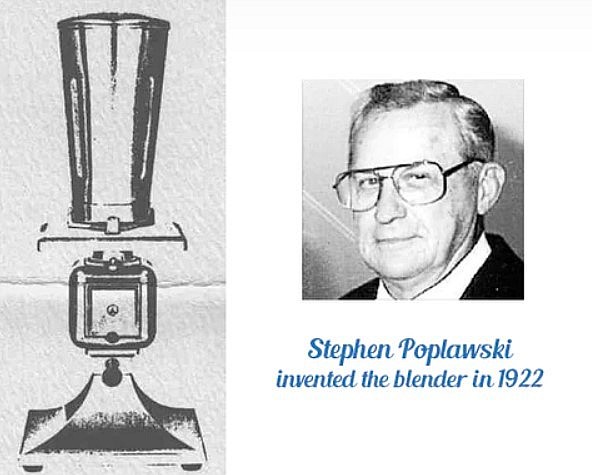 |
| First Blender by Stephen Poplawski |
Although it shouldn't always be the case, the inventory is meant to be connected to the invention. Consider the blender as an illustration. Although it was created by Stephen Poplawski in 1922, the most common name given to the contemporary electric kitchen appliance is Fred Waring.
One major factor was that Frederick Osius, a tinkerer who was creating a device somewhat akin to Poplawski's blender, received financial support from Waring, the conductor of the orchestra. Waring intended to use the apparatus to prepare a raw vegetable cocktail for his diet. When Waring's blender first went on sale in 1937, it cost $29.75. By 1954, one million blenders had been sold.
53. First Circular Saw - 1923
 |
| First Circular Saw: By 1937, the first Skilsaw Model 77 was born – a classic design that built the foundation of today’s Skilsaw Model 77 circular saw. |
The sawmill's spinning blades were too large for Edmond Michel to use as home woodworking tools, so he created a new, portable design that replicated the mill's wood-cutting operation. He developed a more straightforward version of the contemporary circular saw in 1923. It needed an external generator to run because it lacked an electric circuit. Michel invented the worm-drive motor at the same time he was building the apparatus.
54. First Self-winding Mechanical Watch - 1923
When the hardwood system was introduced in 1923, it was the first mechanical watch that was known to wind itself. However, the mechanism was overly intricate, and the mainspring could only rotate 180 degrees. In 1931, Rolex refined the design by utilizing a unidirectional rotor.
However, because of its heavier rotors and jewel bearings, the Eterna Watch was the first mechanical watch that could be relied upon to wind itself. The actual rotor differed from the one recommended by Rolex. As the rotor, Eterna invented a tiny engineering marvel known as the "ball bearing."
55. First Television by Paul Nipkow - 1925 (1884)
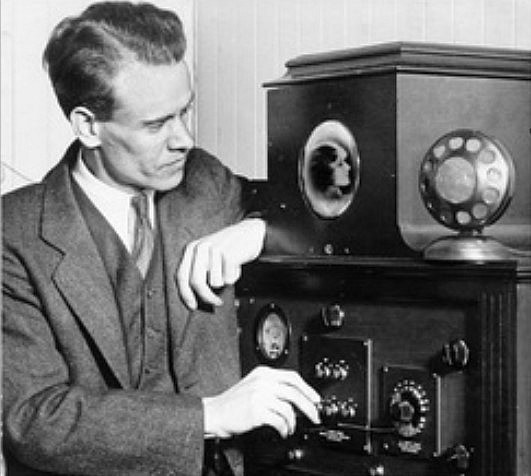 |
| The first television was created in 1884 by a man named Paul Nipkow who was 33 years old. |
The development of television involved a large number of people. Thomas Edison and Alexander Graham Bell both proposed simultaneous image and sound transmission theories.
Despite being a necessary component of our daily lives, television evolved quickly in the 19th and 20th centuries thanks to the efforts of many individuals.
The image rasterizer was invented in 1884 by Paul Julius Gottlieb Nipkow, a 23-year-old German university student. It was a rotating disk with a spiral pattern of holes on it, each of which scanned a line in an image.
Georges Rignoux and A. Fournier accomplished the first demonstration of instantaneous image transmission in Paris in 1909 AD. Boris Rosing and his pupil Vladimir Zworykin developed a system in 1911 AD that sent rudimentary images via wires to a cathode ray tube or inside a receiver using a mechanical mirror-drum scanner. However, the system's sensitivity was insufficient to support moving images.
Scottish inventor John Logie Baird developed a video system prototype in the 1920s using the Nipkow disk. Baird presented the first public demonstration of moving television images in AD 1925. Later, in AD 1927, he demonstrated how to use telephone lines to transmit an image of a moving face. Most people agree that this was the first public television demonstration ever.
Read more: What is the first television in the world and who invented it?
| The world has changed since the introduction of contemporary television in 1939 at the New York World's Fair. People were able to witness historical events thanks to technology. Merely one million Americans possessed a television by the close of 1949. But four years later, the figure soared to about 25 million. |
56. First Transistors - 1926
Transistors are a basic part of almost all contemporary electronic devices. Julius Lilienfeld patented a field-effect transistor in 1926 AD, but the device was not practical at the time.
At Bell Laboratories in 1947 AD, John Bardeen, Walter Brattain, and William Shockley created the first useful transistor device. For this invention, the trio received the 1956 Nobel Prize in Physics.
Since then, transistors have significantly advanced technology by becoming an essential component of the circuitry in a vast array of electronic devices, such as computers, cellphones, and televisions.
57. First Power Steering - 1926 (1876)
Despite the fact that the first power steering system was introduced in an automobile in 1876, a fully functional system was not introduced until 1926. The idea originated with Francis W. Davis, an engineer for Pierce-Arrow's truck division, who initiated the development. He then went on to General Motors, where his idea was turned down due to concerns about higher production costs.
Following the rejection, Davis joined the Bendix auto parts company. The demand for power steering increased as a result of the military's requirement during World War II for a system that assisted steering for heavy vehicles. Ultimately, the Hydraguide, a commercially available vehicle with power steering, was first introduced by Chrysler in 1951.
58. First LED - 1927
In 1927, Oleg Vladimirovich Losev created the LED, but he was the only one who could find a practical application for it. He called his invention Light Relay and filed a patent for it. In 1962, Nick Holonyak of General Electric is credited with creating the first usable visible-spectrum LED. LED efficiency has been increasing since then.
59. First Refrigerator - 1927
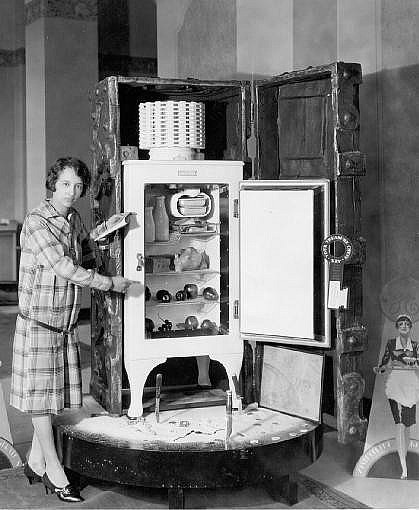 |
| First Refrigerator - 1927 |
The first workable vapor compression refrigeration system was constructed by James Harrison. However, the General Electric "Monitor-Top" refrigerator, which went on sale in 1927, was the first widely used commercial refrigerator. In the 1930s, the refrigerator market experienced a surge with the introduction of Freon, which offered a low-toxicity and safer substitute for the previous refrigerants.
 What is the World's First Refrigerator Ever Made - History in Timeline What is the World's First Refrigerator Ever Made - History in Timeline |
60. First Sunglasses - 1929
 |
| Sunglasses - 1929 |
Even though eye protection dates back to the 12th century, Sam Foster introduced the first mass-produced sunglasses in modern times in 1929, ten years after he founded the Foster Grant Plastic Company. He initially concentrated on producing hair accessories for women, but it was a wise move for him to change the company's course.
After Foster's first pair of sunglasses was sold in Boardwalk, New Jersey, things only got better. By 1930, sunglasses were available in almost every American retailer. His company was expanding quickly, so he used an injection molding manufacturing technique that completely changed the nation's plastic production.
61. First Jet Engine - 1930
About 150 B.C., the Aeolipile, the first jet engine known to science, was created. However, it was insufficiently useful to propel an aircraft. Hans von Ohain and Sir Frank Whittle should have shared credit for creating the first working jet engine, even though they did not collaborate and were probably unaware of each other's work.
The first jet engine installed on an aircraft was actually built by Hans von Ohain, who achieved a successful flight on August 27, 1939. Although Frank Whittle didn't test the engine in flight until two years after Ohain did, he received his patent for the turbo engine in 1930.
62. First Tape Recorder - 1930s
The 1930s saw the development of modern tape recording as we know it, thanks to the cooperation of IG Farben, AEG, and state radio RRG in Germany. Fritz Pfleumer's 1928 invention of oxide-powder lacquered paper tape served as the foundation for everything.
The majority of Americans were unaware of the potential benefits of tape recording until after World War II. The craze began in 1945 when Jack Mullin of the U.S. Army's Signal Corps brought two German recordings home.
63. First Breathalyzer - 1931 (1874)
Francis E. Anstie discovered that tiny amounts of alcohol were exhaled in the breath in 1874, which sparked research into creating a device that could detect the amount of alcohol in the air. The world would have to wait more than fifty years to witness the first useful gadget that could accomplish that.
Rolla Drunkometer's invention was credited to Neil Harger of Indiana University School of Medicine in 1931. The apparatus held an acidified potassium permanganate solution that would change color when it came into contact with breath tainted with alcohol.
64. First Pacemaker - 1932
Many people are contributed to the success of the pacemaker. One of the early models was invented by Albert Hyman in 1932; it was called the artificial pacemaker. He tried it on animals but never published human-testing results, partly because people thought he was using it to “revive the dead.” In 1958, Arne Larsson became the first patient to receive an implantable pacemaker designed by Rune Elmqvist. He received 26 pacemakers throughout his life. He died at the age of 86 in 2001, outliving the inventor of the pacemaker and the surgeon, Ake Senning.
65. First Artificial Heart - 1937
The first artificial heart was implanted into an animal, as is the case with many medical devices. In 1937, Vladimir Demikhov successfully attempted to implant a prosthetic heart into a dog. It is a different matter entirely to implant it into a human being; Dr. Robert Jarvik is recognized for having created the first permanent artificial heart that functionsed. Dr. Willem Kollf operated on a patient named Barney Clark in 1982 to perform the first surgical implant of an artificial heart.
66. First Teflon Pan - 1938
Roy Plunkett made the discovery of polytetrafluoroethylene, or PTFE, in 1938 at the DuPont research laboratories. Tetrafluoroethylene (TFE) was inadvertently frozen and compressed in the lab, despite the fact that the research was intended to examine CFC and a few other related gases. It got to the point where almost nothing stuck to it. It turned out that PTEE was not able to absorb chemicals from other materials that it came into contact with. In 1945, DuPont registered the trademark for the new material, which they named Teflon. These days, it's commonly utilized in cooking utensils like pans, where producers use sandblasting to roughen the surface and then coat it with Teflon.
67. First Portable Air Conditioner - 1939
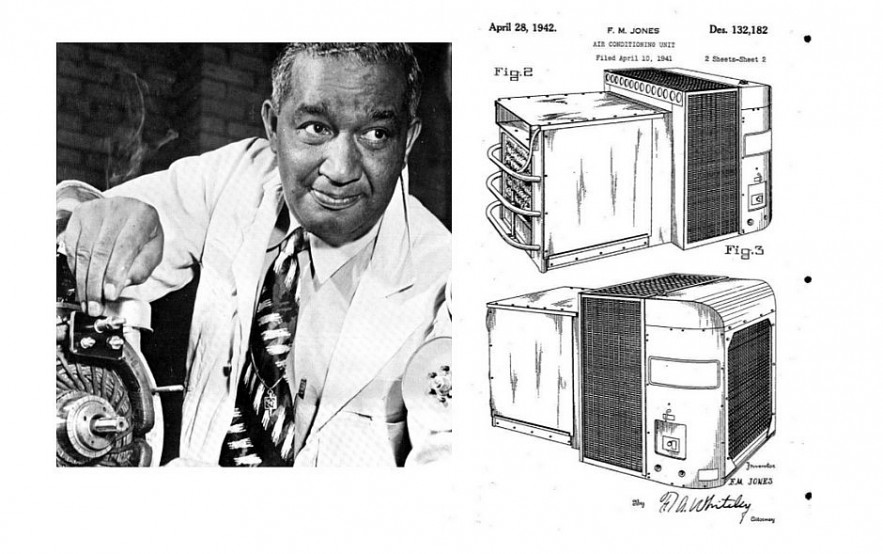 |
| Frederick McKinley Jones |
In the past, air conditioning systems were dependent on the elements. In order to use them in the sweltering summer, people collected and stored snow and ice during the winter. That antiquated notion was replaced by mechanical ice makers, which were later replaced by electric air conditioners.
Approximately one million units were sold following Willis Carrier's 1939 debut of the device at the New York World's Fair.
In 1939, Frederick McKinley Jones patented the first successful refrigerated transportation system in history, having designed a portable air-cooling unit for trucks. In addition, he founded the US Thermo Control Company, whose cooling units were crucial in World War II for the preservation of food, medicine, and blood.
 How To Choose The Right Portable Air Conditioner For Home? How To Choose The Right Portable Air Conditioner For Home? |
68. Flight Recorder - 1939
Paul Beaudouin and Francois Hussenot created the Type HB flight recorder in 1939, which was among the earliest and most successful models. It was an 88mm wide film flight recorder that was based on photographs. In the UK, Vic Husband and Len Harrison created the first authentic modern flight recorder. Not only could it survive strong impacts even when passengers and flight crews could not, it was also capable of recording crucial flight data.
69. First Helicopter - 1939/1941
Though it was only a drawing, Leonardo da Vinci most likely created something that appeared to be a helicopter. Between 1939 and 1941, Igor Sikorsky conducted a number of successful flight tests on his VS-300 following a protracted period of development. Sikorsky's helicopter was relatively simple, with only a 65 horsepower engine, but most modern helicopters have similar features, like a tail rotor and a three-bladed main rotor.
70. First Binoculars - 1941
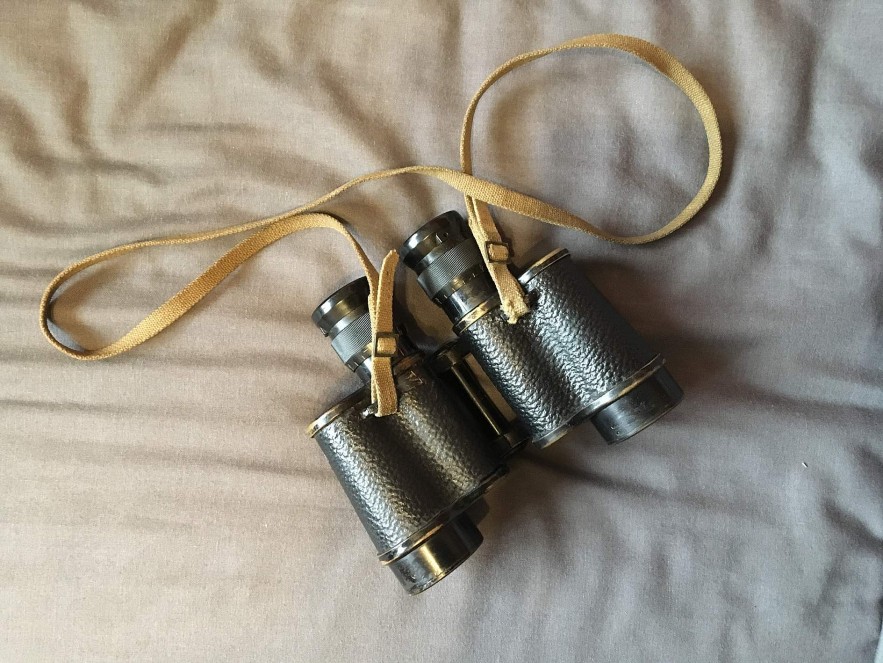 |
| First Binoculars - 1941 |
Binoculars are another example of a traditional tool that gained popularity and accessibility for the general public as a result of modernization. Before 1941, binoculars were primarily expensive, handcrafted pieces of specialty equipment. It was necessary to import even the lenses from Germany.
The need to find a way to mass-produce binoculars quickly and cheaply intensified when the United States entered World War II. Effective binoculars did not have to be costly, thanks to a reconfiguration of the film manufacturing process by the Universal Film Company. After the war, binoculars helped to popularize bird-watching as a new pastime.
71. First Microwave Oven - 1945
Before the invention of the microwave, people had to wait—yes, wait—to cook or reheat their food. Reheating a meal would frequently require an hour or longer.
When Percy Spencer was employed by Raytheon in 1945, he made the accidental discovery of the microwave while experimenting with a chocolate bar. The bar he had in his pocket began to melt when he noticed this. The first appliances, which are now commonplace in kitchens, were 1.8 meters tall, weighed 340 kilograms, and cost approximately £3,000, which was likely ten times the price of a house at the time. The patent was granted in 1947.
We can now all prepare a TV dinner in a matter of minutes thanks to technological advancements, and we can thank melting chocolate for this.
72. First Ballpoint Pen - 1945
Although calligraphy and writing date back thousands of years, ballpoint pens are relatively new. The Reynolds Rocket, the country's first ballpoint pen, was first available for purchase at Gimbels in October 1945; it cost roughly $12.50, or $170 in 2017 currency.
Long before Milton Reynolds did, countless people had tried to make a dependable ballpoint pen. Although many of the earlier designs were quite good, the Reynolds Rocket was the first to be commercially successful. In the years that followed, market competition forced the price to drop considerably as more businesses started to sell comparable goods.
73. Mobile phone services - 1947
Bell Laboratories launched the first mobile phone service in Missouri in 1947.
During World War II (1939–1945), radio-telephony links were used by the military. Since the 1940s, portable radio transceivers have been accessible. Several phone companies started offering mobile phones for cars in the 1940s. Early devices were heavy, power-hungry, and could only handle a small number of concurrent conversations on the network. (The ubiquitous and automatic use of mobile phones for data and voice communication is made possible by modern cellular networks.)
Bell Labs engineers in the United States started developing a system that would enable mobile users to make and receive phone calls from their cars, and on June 17, 1946, mobile service was launched in St. Louis, Missouri. AT&T introduced mobile phone service shortly after. There were few available channels in urban areas and a restricted coverage area for a wide range of mobile phone services that were mostly incompatible. Eavesdropping was possible for anyone with radio equipment capable of receiving those frequencies, as calls were sent as unencrypted analog signals. The commercial introduction of cellular technology (in Japan in 1979) made it possible for mobile phones to be widely adopted at an affordable cost by allowing frequencies to be reused multiple times in small, nearby areas covered by transmitters with relatively low power.
Moscow-born engineer Leonid Kupriyanovich created and demonstrated several experimental pocket-sized communications radios in the USSR between 1957 and 1961.
At the Inforga-65 international exhibition in Moscow in 1965, the Bulgarian company "Radioelektronika" showcased a mobile automatic phone that was paired with a base station. This phone's solutions were built around a system created by Leonid Kupriyanovich. Fifteen customers could be served by a single base station that was linked to a single telephone wire line.
The Biggest Inventions of All Time
74. First DVD player - 1949
From black and white to VHS to Blu-ray, the entertainment industry has evolved over the years. Who knows what new technological advances will arise in the future? Again in 1994, Toshiba developed a prototype for the DVD player. The first prototype, known as Fire Tower, was an intricate and somewhat disorganized stack of circuit boards; Vanguard, the second prototype, was considerably more orderly.
Though neat as it was, the prototype demonstrated how much better the audio and video quality on DVDs was than that of VHS. When they were first made available for purchase in 1996, the first feature film was quickly released on DVD.
75. First Modem - 1949
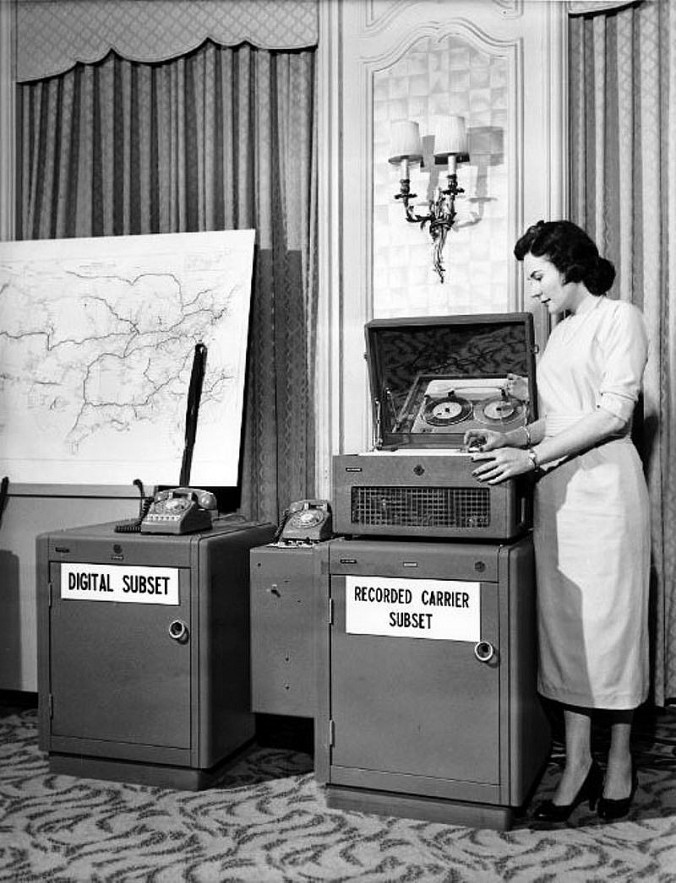 |
| Through modems, computers can "talk" over regular voice phone lines. The modem was created in 1949 by Jack Harrington's team at the Air Force Cambridge Research Center (AFCRC) near Boston for the purpose of transmitting radar signals. It converts digital data into sounds and demodulates sounds that are received back into digital data. (MODEM = MODulation + DEModulation). Bell Telephone plans to commercialize modems in 1958 after they are adapted for use with computers in 1953 for the SAGE system. |
The terms "modulation" and "demodulation" do give some hint as to how it operates. In 1949, the U.S. Air Force became one of the first users of the modem when it was incorporated into radar systems.
Radar data was transformed into audio and transmitted over phone lines. The sounds were transformed back into data at the other end. Even so, the transmission was excessively slow compared to other data transmission methods. Not even 40 years after the modem-based radar technology was developed, could open an email at a transmission rate of only 56 kbps.
76. First Pager - 1949
Alfred J. Gross received the first patent for the telephone pager system in 1949. Back then, pagers were the only "portable method" for sending a digital text message to someone because most phones did not have keyboards. This was actually foreseen by Nikola Tesla in 1909 when he predicted that wireless message transmission would become possible in due course.
Of course, with the advent of the BlackBerry, texting became a real phenomenon. BlackBerry (then known as RIM) debuted the Inter@ctive Pager in 1996. The gadget made it possible for users to send and receive text messages over a wireless data network. Even children can now tweet to share their thoughts with the entire world.
77. First Chainsaw - 1875/1949
The first chainsaw model was not what you might think it was, as it was published in a 1785 book by John Aitken titled "Principles of Midwifery, or Puerperal Medicine." The tree-trimming device is the first thing that springs to mind when you hear the word chainsaw.
The purpose of that chainsaw was to cut out damaged bone. Nearly all chainsaws were large and required at least two pairs of strong, dexterous hands to operate until 1949. In 1949, McCulloch Motors Corp. released a lightweight, portable chainsaw that allowed anyone to be a terrifying backyard warrior, trimming small trees and gathering firewood.
78. First Credit Cards - 1950
 |
| First Credit Cards - 1950 |
The majority of people paid with cash at the start of the 20th century.
Around 1950, Ralph Schneider and Frank McNamara, the creators of Diners Club, introduced the concept of a credit card, allowing customers to sign for their food and pay for it later. As technology develops, using credit to pay for everyday purchases has become commonplace.
Though they are a curse on many people's lives these days, when used wisely, they can be very helpful.
79. First Computer - 1947/1971
Computers have completely changed how people live and work by making tasks simpler, storing information, and processing data fast and effectively.
The path to personal computers was paved with the 1947 invention of the transistor, also known as a semiconductor. This part, which took the place of the vacuum tube, allowed electronic devices to get smaller and more dependable. As the original personal computer, Kenbak-1 is credited to John Blankenbaker. Microprocessors were a significant advancement in the creation of the PC (1971).
The Micral was the first personal computer to use a microprocessor, released in 1973. The Xerox Alto (1973), despite never being sold, was the precursor to home computing as it was the first device to use a mouse and graphical user interface. The first computer to use the Microsoft Basic programming language was the Altair 8800, which was introduced in 1975 and was created by Microsoft's founders Bill Gates and Paul Allen.
| Kits were used to sell early personal computers. In January 1975, MITS, a comparatively small company that specialized in producing electronic kits for enthusiasts, launched the Altair 8800. In the first month of production, MITS received thousands of orders, even though the general public was not the target consumer. In 1981, IBM unveiled the 5150, also referred to as the “IBM PC,” which marked the gradual mainstreaming of home computers as personal devices. |
80. First Computer Mouse - 1952
In 1952, researchers in the Royal Canadian Navy brought the computer mouse to the world. It was not as small as a mouse—a better moniker for it would be capybara. Duckpin bowling ball was used to make the trackball. Douglas C. Engelbart is credited with creating the computer mouse, in part because the form factor served as the model for all contemporary computer mice. It didn't become more than a basic peripheral until Apple connected a mouse to the Lisa computer.
81. First Laptop - 1975
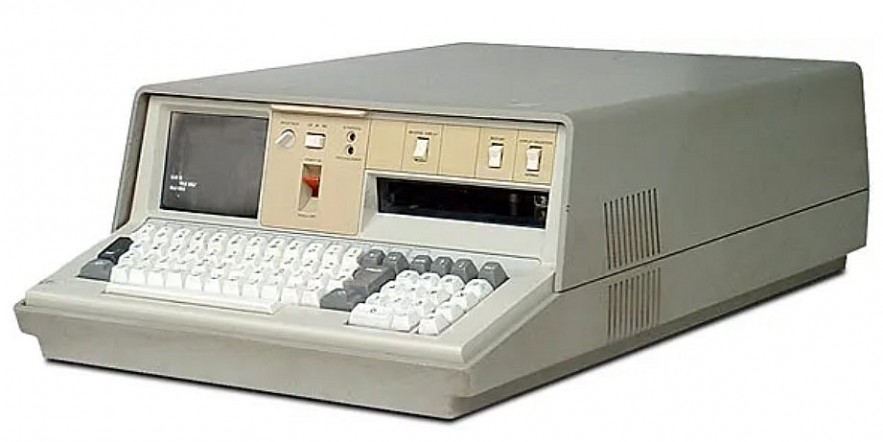 |
| First Laptop - 1975: Unbelievably, the IBM 5100 was formerly regarded as a portable personal computer. A fully self-contained computer that included a keyboard, monitor, and storage, the 5100 was the first of its kind, weighing only 25 kg and packing a powerful 16 kilobytes of memory. Plus, it was a great deal, with prices between US$9,000 and US$20,000. |
The concept of a portable personal computer naturally emerged after the introduction of the personal computer in 1971. Introduced in 1975, the IBM 5100 was one of the first laptops—or something akin to one—to be sold commercially. It had a five-inch CRT display.
Nonetheless, the GRiD Compass 101, with its recognizable clamshell design, 320x240 pixel resolution display, 1,200 bit/s modem, and Intel 8086 processor, really laid the groundwork for laptops to come. It could also be used with an external connection to connect to a hard drive and floppy drive. NASA and the US Military both utilized it when it was released in 1982.
82. First Internet - 1950s
The Internet did not have a single "inventor," like other inventions. Rather, it has changed over time. It started in the 1950s, concurrently with the advancement of computer technology.
With the establishment of ARPANET, or the Advanced Research Projects Agency Network, in the late 1960s, the first functional prototype of the Internet was created. Following ARPANET's adoption of the TCP/IP protocols in 1983, scientists set about assembling the "network of networks" that would eventually give rise to the modern Internet.
83. First Robot - 1950s
Robots carry out difficult, monotonous, and occasionally hazardous tasks.The play R.U.R. (Rossum's Universal Robots), written in 1921 by Czech playwright Karl Capek, is where the word "robot" first appeared. Ironically, science fiction author Isaac Asimov popularized the term "robotics" with his 1942 short story "Runabout."
But the history of robots is very old. An Egyptian water clock used mechanical human figurines to strike the hour bells circa 3000 B.C. The first mechanical design was this. As time passed, new innovations and technology emerged.
In the 1950s, George C. Devol created and patented "Unimate," a reprogrammable manipulator that set the groundwork for modern robots.
Joseph Engleberger changed the Unimate into an industrial robot after acquiring the patent in the late 1960s. This has earned him the moniker "the Father of Robotics." They are genuinely groundbreaking inventions that have only recently begun to impact society.
84. First The Pill- 1951
The contraceptive pill was developed by a team headed by Carl Djerassi, a chemist, in 1951, but wasn't marketed in the UK until 1962.
85. First Video Tape - 1951
Before the video cassette, the only ways to watch contemporary movies were when they came out and the several years it would take for them to appear on television. This frequently coincided with holidays like Christmas, when a new James Bond movie was planned.
Television companies were the first to use the video tape invention in 1951, and the first machine to be sold commercially cost an astounding £30,000 in 1956. The first machines weren't even visible in stores until 1971, when Sony introduced them.
In the 1980s, Betamax and Philips attempted to enter the video player market, but the availability of new movies at the neighborhood video rental store soon caused them to lose ground to those desiring VHS players in terms of sales.
86. First Speech Recognition Machine - 1952
These days, speech recognition software can be purchased for a low price, and your smartphone most likely already has it installed. When Bell Labs researchers developed single-speaker recognition in 1952 by detecting speech sound spectrum frequency, they were the first to use the technology. It could only recognize about ten words at a time. Gunnar Fant developed a useful speech recognition model in 1960. Thirty years later, the Dragon Dictate, which sold for $9,000 each, became the first speech recognition device to be successful on the market.
87. First Drip Coffeemaker - 1954
Before the advent of the drip coffeemaker, traditional percolators had dominated the coffee-making industry for more than a century. Germany's Gottlob Widmann received the first patent for the electric drip coffeemaker in 1954. Mr. Coffee, a Newell Brands subsidiary, helped drip coffeemakers gain popularity in the US. The machine operates in a manner that is nearly identical to the percolator, but with a more straightforward procedure. In the United States, about 14 million drip coffee makers are sold annually.
88. Electric toothbrush - 1954
Dr. Philippe Guy Woog created the first electric toothbrush, called Broxodent, for Broxo S.A. in 1954. It was intended for individuals with limited motor skills and orthodontic patients. It required to be plugged into an electrical outlet in order to operate; it was not battery-operated. In 1960, Broxodent, an electric toothbrush, was introduced to the United States by E. R. Squibb and Sons Pharmaceuticals. General Electrics was the first electric toothbrush made in the United States to hit the market in 1961. It was also better than previous models.
89. First Digital Thermometer - 1954 (1714)
Although Galileo Galilei is frequently credited with creating the thermometer, his creation was more accurately a thermoscope because it could only detect variations in temperature. Daniel Gabriel Fahrenheit used mercury to create the first accurate thermometer in 1714. It was initially observed in 1954 with a probe that held a tiny Carboloy thermistor.
90. Artificial Intelligence (AI) – 1956
Although the concept had been around for decades, it was unfamiliar to many people until the 1950s.
The term "Artificial Intelligence" (AI) first appeared in the summer of 1956, when American computer scientist John McCarthy used it at the Dartmouth Conference to describe the technical science of creating machines. Intelligence can mimic human behavior.
McCarthy, along with Alan Turing, Allen Newell, Herbert A. Simon, and Marvin Minsky, are regarded as the fathers of AI. Alan made the first AI suggestion, stating that if humans can solve problems and make decisions using available information and rational thinking, why can't machines?
At the time, it was predicted that a machine as intelligent as a human could be created, and they were given millions of dollars to make this happen.
In the early decades of the twenty-first century, investment in artificial intelligence increased dramatically. Because of the explosion and rapid development of computers, machine learning has been successfully applied to a wide range of academic and industrial problems.
Read more: Who Invented Artificial Intelligence: History and Timeline of AI
91. First Microchip- 1958
US engineer Jack Kilby built the world's first monolithic integrated circuit, or microchip that changed the world of computing.
92. First Laser- 1960
The term Light Amplification by Stimulated Emission of Radiation is commonly shortened to "laser."
Theodore Maiman, an American physicist, invented the solid state ruby laser for the first time in 1960 at Hughes Laboratory in Malibu, California. This was patented by Maiman on November 14, 1967, and is regarded as the world's first laser. Aluminum oxide and chromium are combined to create rubies. Only pink light is left behind when chromium absorbs green and blue light.
When Albert Einstein realized that two types of emission were possible, he unintentionally took the first step toward the development of lasers. The maser, a device that works similarly to a laser but emits microwaves instead of light, is the source of inspiration for lasers. Microwave Amplification by Stimulation Emission of Radiation is known by its acronym, Maser.
In 1953, Charles H. Toweres developed the first maser with assistance from J.P. Gordon and H.J. Zeiger, two graduate students. The first maser did not continuously generate waves.
Two Soviet scientists, Nikolay Gennadiyevich Basov and Alexander Mikhailovich Prokhorov, developed a continuous beam system employing more than two energy levels while working separately in the field of quantum fluctuations.
Charles Townes, Nikolai Basov, and Aleksandr Prokhorov shared the 1964 Nobel Prize in Physics for their work laying the groundwork for quantum electronics, which in turn led to the development of maser-laser theory-based oscillators and magnifiers.
93. First Kidney dialysis machine - 1960
The kidney dialysis machine was created by Dr. Willem Kollf, the same physician who carried out the first successful surgical procedure to implant an artificial heart into a human being. Even though the machine didn't work well in the beginning, he persisted in refining it and ended up saving countless lives. When Dr. Belding Scribner created the Teflon shunt, which could be permanently inserted into patients' arms, in 1960, significant advancements were made. During dialysis, patients' blood does not clot thanks to Scribner's shunts.
94. First Internet - 1960s
The foundation for the modern Internet was established in the 1960s by a project known as ARPANET, which was supported by the US Department of Defense. Though its functionality was restricted to a single network, ARPANET was successful in creating a network that allowed multiple computers to send and receive data. The Internet Protocol Suite (TCP/IP), created in the 1970s by Vint Cerf and Robert E. Kahn, became the de facto standard networking protocol for the ARPANET and the contemporary Internet.
EthernetOptimizing the functionality of the Internet was also greatly aided by the development and invention of Ethernet. The task of figuring out how to link the world's first laser printer and the Xerox Alto, the first personal workstation with a graphical user interface rather than a coding language, fell to several PARC members, including David Boggs and Metcalfe. They completed the work in just a single year. The World Wide Web, TCP/IP, ARPANET, and Ethernet standardization initiatives all contributed to the globalization of society. |
95. First Digital camera - 1961
In order to mark astronauts' positions during space exploration based on pictures of planets and stars they could take while in orbit, the concept of the filmless camera was first proposed in 1961. Eugene F. Lally of Jet Propulsion Laboratory made the suggestion. Willis Adcock, a Texas Instruments employee, also submitted a filmless camera patent application in 1972. The public never saw either of these concepts. The 1988-developed Fuji DS-1P was an additional attempt, but it was never put into production. The Dycam Model 1, popularly referred to as the Logitech Fotoman, was the first model to achieve commercial success in 1990. Nineteen years later, Kodak discontinued its Kodachrome film format.
96. First Compact Cassette tape - 1962
Philips introduced the first compact cassette tapes in 1962, and the first dictation machine shortly after in 1963. The world soon discovered that blank cassette tapes were a popular product, and many aspiring singers used them in their bedrooms, offices, and homes. Philips was unprepared for this. Cassette decks became commonplace for portable recorders, cars, and home audio systems. When the portable music player known as the Sony Walkman was created in 1979, its popularity skyrocketed.
97. First Plasma television - 1964
The first flat-screen monitor was created in July 1964 by Donald Bitzer, Gene Slottow, and Robert Willson at the University of Illinois. Their goal was to overcome the drawbacks of the standard computer monitor, particularly when it came to applications involving graphics. The plasma display was created by their flat screen's use of plasma technology to emit light. Ironically, this meant that the development of true flat screens would be delayed for several decades as many manufacturers were already working on the LCD screen. As a joint venture, Sony and Sharp started making real big flat screens in 1996. A 42-inch TV was put up for sale a year later.
98. First CD-ROM - 1966
If you've ever dealt with floppy disks, you'd understand how much easier life was made with the CD, even though it seems like such a simple invention. It was created by James T. Russell in 1966.
Despite being invented in 1966, the first CD player wasn't commercially available until 1982, and even then, it cost more than $1,000 apiece. Between 1983 and 1984, more than 400,000 players were sold despite the high asking price. In 1979, Sony and Philips worked to standardize the format, making it possible for anyone to buy any CD or player from any company without worrying about compatibility problems.
99. First ATM (Automated Teller Machine) - 1967
An important development in contemporary banking is the creation of the ATM (Automated Teller Machine). Millions of ATMs are in use worldwide, according to the ATM Industry Association (ATMIA).
An ATM can be used for a number of different tasks, including checking balances, crediting mobile phones, and cash withdrawals. Many experts agree that Luther Simjian's invention, the Bankograph, was the first ATM.
John Shepherd-Barron headed the team that devised the brilliant concept of a money vending machine, which was adopted by Barclays, a London-based bank, in 1967. Radioactive carbon-14 impregnated single-use tokens were utilized by these machines. The device identified the radioactive signal and cross-referenced it with a PIN entered on a keypad.
100. First Video Games Consoles - 1968
When Ralph Baer created the Magnavox Odyssey in 1968, it revolutionized how both adults and kids passed their leisure time. He is regarded as one of the most significant entertainment innovators of the modern era and was also in charge of the 1980s commercial hit Simon and the introduction of the light gun.
101. First Boombox - 1966 - 1969
first made available by the Netherlands' Philips between 1966 and 1969. The idea was to give listeners a way to record radio shows to a cassette using just one device. Similar products were also developed by other European brands, such as German company Grundig. Because the original boombox was so well-liked in Japan, numerous other companies decided to develop similar products. Boomboxes manufactured in Japan quickly dominated the European market. The boombox began to gain traction in the United States in the middle of the 1970s, and well-known manufacturers like Panasonic, General Electric, Sony, and Marantz produced them. Eventually, the CD player caught up and started to be a standard feature in many units starting in the 1980s.
102. First Printer - 1969
The laser printer that we use today, like many other computer-related technologies and accessories, is the outcome of ongoing innovation by several parties. At Xerox PARC (Palo Alto Research Center), the first laser printer was created between 1969 and 1971. Just six years later, Xerox released the "9700 Electronic Printing System," a new model based on the research. It included character generation, page formatting, laser scanning, and every other feature one could ask for in a printer.
In 1976, IBM began producing an industrial-grade laser printer that could produce 100 impressions per minute, which was prior to Xerox releasing the 9700. It was actually a step ahead of Xerox; according to IBM, the first one was installed in an accounting office that same year. IBM claims that it was the first printer to simultaneously use electrophotography and laser technology.
In 1988, Hewlett-Packard achieved a breakthrough with its DeskJet inkjet printer rather than a laser printer. It became a feasible home computer accessory since the company could produce it at a comparatively low cost of production. Nonetheless, the cost was $1,000. An HP DeskJet can now be purchased for $40 or less.
103. First Lithium Batteries - 1970s
Lithium is one of the elements in the periodic table with the greatest electrochemical properties and the lowest weight. M. Stanley Whittingham of Binghamton University originally proposed the concept of the lithium battery in the 1970s while he was employed by Exxon. Because titanium sulfide and lithium metal were not good choices for materials, the design was not practical enough for daily use.
When John Goodenough and Koichi Mizushima created a novel kind of battery in 1980 that allowed lithium to move as a Li+ ion between electrodes, it was a significant development. 1991 saw the release of the first lithium-ion battery for commercial use by Sony and Asahi Kasei.
104. First VCR (Videocassette recorders) - 1970
Although the former was based on the latter, videocassette recorders and video tape recorders are two different things. The VCR format was created by Philips in 1970 especially for television stations, but it wasn't until two years later made available to the general public. Video Cassette Recording was Philips' name for it, and people called it "the N1500" (the device's original model).
By 1975, when VCRs became widely available, six well-known companies had made significant contributions to the technology: JVC, RCA, Sony, Matsushita Electric (Panasonic), Toshiba, and AMPEX. The Japanese electronics produced by Sony, JVC, and Matsushita Electric dominated the market among those companies' offerings. Such devices, in the opinion of Motion Pictures of America president Jack Valenti in 1982, were nothing more than barbarism for the motion picture business. However, in 1984, the Supreme Court finally gave VCRs permission to be used for home recording.
105. First Email - 1971
The majority of early mainframe and minicomputer programmers created mail applications that were similar but frequently incompatible. These were eventually connected by a network of routing and gateway systems.
Because so many US universities were connected to the ARPANET, software could be more easily transferred between its systems. The Simple Mail Transfer Protocol (SMTP) gained popularity due to its portability. In AD 1971, the first email on the ARPANET was sent.
One widely used feature of the modern email system is attributed to Ray Tomlinson. When working as an ARPANET contractor in 1972 AD, Tomlinson used the @ symbol to indicate sending messages between computers.
Email had taken on its current form by the middle of the 1970s. Today, email is the primary means of official business communication.
106. First Floppy disk - 1971
Following its 1971 introduction by IBM, the floppy disk underwent further development, going from an eight-inch large size to the final, most advantageous form factor of just 3.5 square inches. The rapid development of portable hard drives and CDs/DVDs has made the actual floppy disk less popular (aside from coasters, perhaps), but its legacy has not entirely disappeared. The floppy disk icons are still used for the "save" and "save as" functions in Microsoft Office Suite applications.
107. First Digital wristwatch - 1972
Electro-Data and the Hamilton Watch Company created the first electronic watch with digital functionality. The goal of Pulsar, a Hamilton Watch division at the time, was to create a futuristic watch that was modeled after Hamilton's fictional one from 2001: A Space Odyssey. The end product was an LED-displayed, 18-carat gold wristwatch. Moreover, it was the original Pulsar watch. When it was first released in 1972, the cost was $2100, or $12,700 after inflation.
108. First Mobilephone and Smartphones - 1973/1999
Theodore G. Paraskevakos filed for a patent in 1973 on the idea of a phone and computer appliance, but the idea was dormant for more than 20 years. While some experimented with using a palmtop computer to manage their lives, NTT Docomo, a Japanese company, produced the first smartphone that was actively marketed in 1999. Over a billion smartphones are in use today, with 90% of devices sold being either Android or Apple products in 2014.
The desire for widespread communication among humans may have given rise to the invention of telephones.
These words, "Mr. Watson, come here, I want you," will always be remembered as the very first spoken over a phone. On March 10, 1876 AD, Alexander Graham Bell told his assistant Thomas Watson about them. This would forever alter the nature of communication.
The advent of the mobile phone in the 1980s freed people from the limitations of wired personal communications.
The telephone industry revolution was aided by the ingenious creation of the cellular network. Mobile phones have advanced significantly, going from large, heavy devices to incredibly thin ones. In 1973, Motorola's John F. Mitchell and Martin Cooper gave a demonstration of the first handheld device, sparking a technological revolution that continues to this day.
| Since the pager, wireless communication technology has advanced significantly. In 1973, Motorola executive and researcher Martin Copper created the first portable handheld phone. The idea of Martin Cooper served as the foundation for subsequent research and development that resulted in the smartphone. Before the DynaTAC 8000x was available in stores, the company had to wait an entire decade. Dynamic Adaptive Total Area Coverage is referred to as DynaTAC. Produced between 1983 and 1994, the initial cost of a single unit was close to $4,000 (roughly $9,500 in 2017). Although Motorola should have received credit for the invention, IBM produced the first real smartphone. The device was known as the Simon Personal Communicator; although the term "smartphone" wasn't coined until 1995, Simon had been around for almost 15 years when Apple first introduced the iPhone. In addition to making and receiving phone calls, IBM's Simon had sufficient features to send and receive faxes, emails, and cellular pages. It even included apps for a calendar, calculator, notepad, handwritten annotations, predictive keyboards, global timekeeping, address book, and appointment scheduling. Even in terms of modern devices, IBM Simon was a capable machine. It even featured a monochrome LCD touchscreen. At launch, the cost included a service contract and was $899, which is now more than $1,500. In the modern world, smartphones are the most commonly used devices. Even the more economical models have a multimedia player, GPS, camera, and Internet access. |
109. First Flash Drive - 1981
Fujio Masuoka, the man who invented the flash drive, was meant to be working for Toshiba on DRAMs (Dynamic Random-Access Memory), but instead he developed the idea for flash memory. The outcome was a flash drive that could store 8,192 bytes of data.
In 1981, he and Hisakazu Iizuka filed a patent application for it. But the memory needed a means of being connected to a computer. The answer came from Ajay Bhatt at Intel in 1996 with the introduction of the Universal Serial Bus (USB). For inventing the flash drive, Toshiba received a small bonus, but Intel made billions of dollars selling USBs and related technology. The foundation for today's much larger capacity flash memories was laid by Fujio Masuoka's invention.
First Apple iPhoneAlthough it wasn't the first smartphone, there are a lot of reasons why it is the most likable. Android is the largest rival in terms of operating systems, though it's unclear which one came first. What is known is that the HTC Dream, the first real Android-powered device, wasn't released until nearly a full year after the original iPhone went on sale. The form, interface, and connectivity options of the iPhone were all heavily influenced by what came before it. |
110. First Digital Camera - 1975
Previously, taking pictures while on vacation meant loading film, sending it somewhere to be developed, and crossing your fingers that the pictures would turn out the way you wanted them to. There was only one chance to capture an amazing moment, there was only one format (hard copy), and blurry photos could not be removed from the roll of film.
In 1975, Steven Sasson, then employed by Eastman Kodak, created an electronic camera that initially found use only in the fields of science and the armed forces. Early models of the technology were not made widely available for purchase until the early 1990s, signaling the start of a revolution in photography.
By the mid-2000s, the majority of mobile phones also had digital cameras installed, and the industry competed for consumers by promising better quality photos and greater storage space. This was due to the smartphone's concurrent development as a necessary device. The surge in social media usage has led to a rise in the use of digital cameras that allow for instantaneous sharing from any location, at any time of day or night.
111. First MP3 Player - 1979
Music had always been available as a visually stored item, whether it was on vinyl, cassette, or CD. You could insert the CD into the player or hold the record while it was placed on the deck.
The iPod did not invent the portable digital audio player; rather, British scientist Kane Kramer introduced an invention known as IXI in 1979. He applied for a patent in 1981, but because of financial difficulties, he did not renew it in 1985.
Apple recognized Kramer as the creator of the digital audio player in 2008. Whatever the disagreement about who invented what, the iPod, like the Kindle, altered the course of history. Users can purchase and listen to new songs on the go more easily because of its compatibility with the iTunes music store.
The German company Fraunhofer-Gesellschaft received a patent in 1989 as a result of their research into music compression. After a failed commercial attempt in 1995, the first MP3 player was finished in 1997. Now, the CD found itself in a similar predicament to that of its musical forebears upon the release of the first players.
112. First Flash Drive - 1980s
The 1980s and 1990s saw the development of personal computers, which led to an increasing demand for storage of data. People's desire for information to be portable from machine to machine was added to this. Although files could be stored on a floppy disc, their storage capacity was extremely constrained. The majority of people had a stack of floppy disks, which frequently scattered across desks and drawers as users' need for access to more files grew.
When Toshiba engineer Fujio Masuoka created the Flash Drive in the early 1980s, this was altered. He gave it this name because deleting data made him think of how quickly a camera flashes. At the time, his concept had no notion of docking with computers, and Ajay Bhatt, who was employed by Intel, was responsible for developing the USB. However, another four years passed before the first flash drive stick was created and released in 2000, boasting a sizable 8 Megabyte storage capacity at the time.
113. First Camcorder - 1983
Originally intended for use in television broadcasting, the first video cameras were bulky and required specific supports to be mounted on. Sony's Betacam system, designed for professional use, was first released in 1983. In the same year, Sony also released the consumer-grade Betamovie BMC-100P, which used Betamax cassette. Users had to mount the bulky equipment on their shoulders in order to record more steadily. JVC released a home camcorder that was less bulky. Americans enjoyed making and watching home videos in the early 1990s; as a result, America's Funniest Home Videos rose to the top of the television ratings.
114. First 3D Printer - 1986
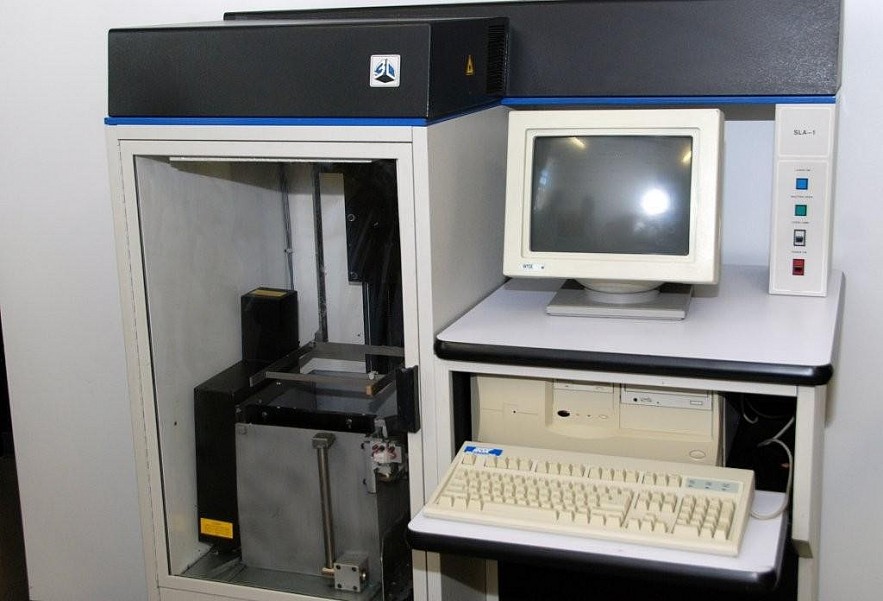 |
| The First Working 3D Printer |
The printer has changed over time. Gone are the big, unreliable machines that used to sit in the office corner with a roll of perforated paper and staff members always trying to solve a paper jam. Instead, the newest kid on the block is already making a name for itself by revolutionizing printing with uses that were unimaginable just a few years ago.
Chuck Hull created the 3D printer in 1986, and while it was useful in specialized fields in its early stages of development, it has only been acknowledged as a truly revolutionary technology with a plethora of uses in the last five years or so.
To create a 3D object, 3D printing involves layering on layer of a selected textile, like plastic.
Applications are expanding at an accelerating rate these days. It is widely used in medical settings to assist with issues like reconstructive surgery and architecture (Holland plans to build houses using 3D printing), apparel, and even food, with patterns created to create favorites like chocolate and ravioli.
Even though they are still very expensive to purchase and are primarily used in the business and industrial sectors, models for home use are being developed, and one will soon be available for about £700.
115. First World Wide Web - 1989
The World Wide Web is a means of gaining access to information via the Internet, while the Internet itself is a networking infrastructure.
The British computer scientist and Internet pioneer Tim Berners-Lee is considered the father of the World Wide Web. The original idea behind the creation of the Web was to satisfy the need for automated information exchange between scientists working in universities and other institutions across the globe.
In March 1989 and May 1990, respectively, Tim Berners-Lee penned the first and second proposals for the World Wide Web. To formalize the idea, Berners-Lee collaborated with Belgian systems engineer Robert Cailliau, and together they described a "WorldWideWeb" where "browsers" could view "hypertext documents".
Berners-Lee launched the first Web server and browser at CERN by the end of 1990. Since the computer platform on which the browser ran was only accessible by a small number of users, work quickly began on a more basic browser that could run on any system.
116. First Handheld GPS - 1989
The United States military actually used GPS as their primary navigation system long before it became widely accessible and reasonably priced. The U.S. government didn't make the technology publicly available until after the Soviet Union shot down a Korean airliner that was operating in a no-fly zone, albeit with certain accuracy restrictions. Magellan produced and sold the first handheld GPS device that was made available for purchase in 1989.
117. First Sewing Machine - 1993 (several centuries ago)
Although mechanical sewing machines have been around for several centuries, the first truly portable sewing machine was introduced in 1993 during the Chicago World's Fair. The small size and aluminum construction of the Singer Manufacturing Company Featherweight allowed it to weigh only 11 pounds. It was produced for thirty-five years. More than three million units were sold between 1933 and 1968.
118. First Palm Pilot - 1996
Today's ubiquitous smartphone is the product of countless innovations from numerous businesses. With the invention of the Palm Pilot in 1996, Palm Computing is one of the companies that helped create the smartphone. The business was still a branch of U.S. Robotics at that point. The three creators, Jeff Hawkins, Donna Dubinsky, and Ed Colligan, began working on the device with the intention of developing handwriting recognition software. It was a real, fully functional PDA with a stylus. The Palm Pilot had a serial communication port but no flash memory.
119. First Wi-Fi Router - 1997
ALOHAnet used the UHF packet network to successfully connect the Hawaiian island. It was most likely the actual original Wi-Fi architecture. The 802.11 protocol made its debut in its initial form in 1997. More than 9,000 gadgets, including laptops, TVs, phones, and even wristwatches, now have Wi-Fi built in.
120. First TV Remote Control
The use of radio-controlling dates back to the late 1890s. The technology was truly patented by Nikola Tesla under the title "Method of an Apparatus for Controlling Mechanism of Moving Vehicle or Vehicles." Zenith invented the first television remote control, but it still required a wire connection to a television. It makes sense that the gadget was given the moniker Lazy Bones. Five years later, Eugene Polley created wireless remote controls.
First Electric GuitarIt's still unclear who invented the electric guitar initially, despite the fact that it seems like everyone wants to be credited with its creation. But two people—Paul Warth, vice president of National Guitar Corporation, and general manager George Beauchamp—designed the first guitar to be truly electrically amplified. The Fender Telecaster, created by Leo Fender, was the first electric guitar to be mass-produced. Though naming it the Broadcaster would have violated copyright, that was his intention. It is still produced today, albeit with numerous changes and alterations. Legend has it that Leo Fender, one of the pioneers of the electric guitar, was not even proficient in tuning an instrument. |
























